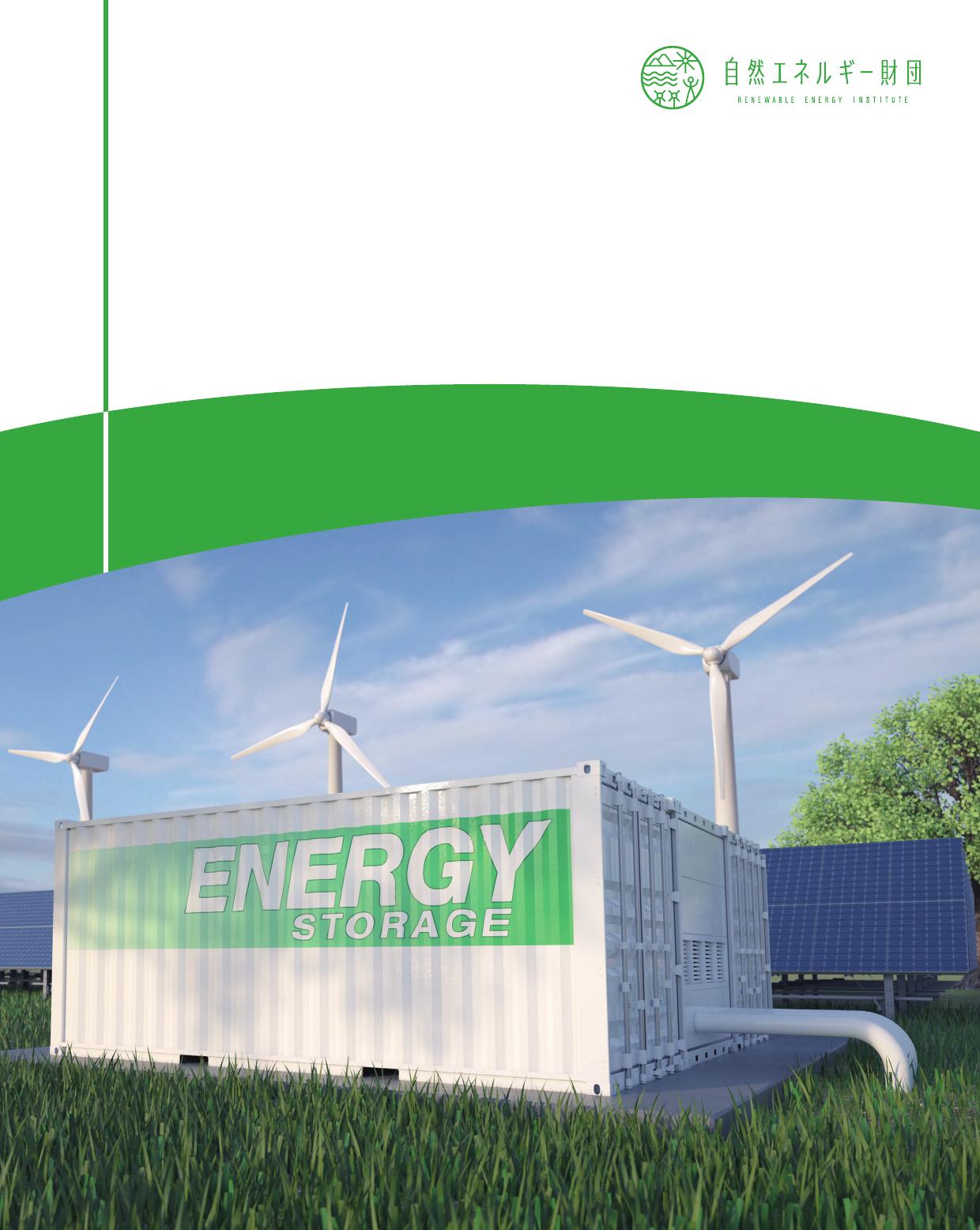#BUUFSZ�4UPSBHF�UP�&⒏DJFOUMZ�"DIJFWF�3FOFXBCMF�&OFSHZ�OUFHSBUJPO+BOVBSZ�����AboutRenewableEnergyInstituteRenewableEnergyInstituteisanon-profittankwhichaimstobuildasustainable,richsocietybasedonrenewableenergy.ItwasestablishedinAugust2011,intheaftermathoftheFukushimaDaiichiNuclearPowerPlantaccident,byitsfounderMr.MasayoshiSon,Chairman&CEOofSoftBankGroup,withhisownresources.AuthorRomainZissler,SeniorResearcher,RenewableEnergyInstituteEditorMasayaIshida,SeniorManager,BusinessAlliance,RenewableEnergyInstitute.AcknowledgementsTheauthorwouldliketothankBloombergNEF,theglobalauthorityoneconomicdataonenergyinvestments,whoallowedRenewableEnergyInstitutetomakeuseofBloombergNEF’sdatainsomekeyillustrationsofthisreport.SuggestedCitation:RenewableEnergyInstitute,BatteryStoragetoEfficientlyAchieveRenewableEnergyIntegration(Tokyo:REI,2023),58pp.Copyright©2023RenewableEnergyInstitutewww.renewable-ei.org/en/DisclaimerAlthoughwehavetakenallpossiblemeasurestoensuretheaccuracyoftheinformationcontainedinthisreport,RenewableEnergyInstituteshallnotbeliableforanydamagecausedtousersbytheuseoftheinformationcontainedherein.1TableofContentsIntroduction.........................................................................................................................................4Chapter1:RoleofBatteryStorageinaSolarandWindPowerFuture..............................................61)FuturePowerSystems–KeyContributionfromBatteries........................................................62)TheFourMajorApplicationsofBatteries...............................................................................133)SevenIllustrativeBatteryProjects..........................................................................................17Chapter2:DeploymentAccelerateswithEconomicCompetitiveness.............................................231)2021RecordGrowthandLeadingMarkets.............................................................................232)DramaticCostReductionandCompetitivenessinthePowerSector..........................................26Chapter3:TechnologicalProgressandImprovementstoCome......................................................341)Short-DurationLithium-IonOverwhelmingDomination.........................................................342)Long-DurationEnergyStorageLagging.......................................................................................36Chapter4:SupportingPolicies...........................................................................................................401)SevenPowerfulPossibilitiestoFurtherAccelerateGrowth....................................................402)Target......................................................................................................................................403)Mandate..................................................................................................................................414)InvestmentTaxCredit.............................................................................................................425)Auction....................................................................................................................................436)MarketDesign.........................................................................................................................447)RECertificateMultiplier..........................................................................................................448)Time-of-usediscountedrate...................................................................................................45Chapter5:ConcentrationsofCriticalMinerals&ManufacturingCapacityandSolutions...............471)ProblematicConcentrationsofCriticalMinerals&ManufacturingCapacity..........................472)SolutionsfromEurope,theUnitedStatesandJapan..............................................................49Conclusion..........................................................................................................................................562ListofChartsChart1:LCOEbyGeneratingTechnology2010-2021...........................................................................6Chart2:GrossElectricityGenerationfromNuclear,SolarandWind2000-2021..................................7Chart3:REShareinElectricityGeneration2021Achievementsand2050Projections........................8Chart4:SimpleIllustrationtoVisualizethePossibleFunctioningofa100%REPowerSystem.........10Chart5:FictionalExampleofa100%REPowerSystem24-hourOperations.....................................11Chart6:FictionalExampleofa100%REPowerSystemWeeklyOperations......................................12Chart7:WorldStationaryEnergyStorageProjectsbyApplication2021(%)......................................14Chart8:CAISOHourlyPowerSystemOperationsOctober24,2022..................................................14Chart9:FictionalExampleofResidentialCustomer-SitedBattery+SolarPV....................................15Chart10:FictionalExampleofCommercialCustomer-SitedBattery+SolarPV.................................16Chart11:TheMobilityHouseTradingEVBatteries’FlexibilityinEPEXSpot......................................22Chart12:WorldStationaryEnergyStorageCumulativeCapacityPower&EnergyOutputs2010-2021............................................................................................................................................................23Chart13:StationaryEnergyStorageCumulativeCapacitySharebyCountry2021(%)......................25Chart14:AveragePackPriceofLithium-IonBatteries2011-2021.....................................................27Chart15:LCOEofUtility-ScaleBattery(4hours)andCompetingAlternativesbyCountry2022H1..28Chart16:LCOEofUtility-ScaleBatteryandCompetingAlternativesintoGreaterDetails:UnitedStates,China,Japan,andUnitedKingdom2022H1...........................................................................29Chart17:LCOEofUtility-ScaleBattery(4hours)+REandCompetingAlternativesbyCountry2022H1......................................................................................................................................................30Chart18:LCOEofUtility-ScaleBattery+REandCompetingAlternativesintoGreaterDetails:UnitedStates,China,Japan,andUnitedKingdom2022H1...........................................................................31Chart19:LCOEofUtility-ScaleBattery+REandStandaloneBatterybyCountry2022H1.................32Chart20:ResidentialBattery+SolarPVLCOEVS.HouseholdElectricityPriceinCalifornia,Japan,andGermany2019-2021...........................................................................................................................33Chart21:WorldUtility-ScaleStationaryEnergyStorageProjectsbyTechnology2021(%)................34Chart22:IllustrationofLiquidLithium-IonBatteriesandSolid-StateLithium-IonBatteries..............35Chart23:TypicalDischargeDurationofDifferentStationaryEnergyStorageTechnologies..............36Chart24:TheBasicPrincipleofCAES.................................................................................................37Chart25:StationaryEnergyStorageTargetsSelectedExamples........................................................41Chart26:UnitedStatesStructureofITCforStationaryEnergyStorageProjects2022.......................42Chart27:GermanyInnovationAuctionsAwardedStorage+SolarProjects2021-2022.....................43Chart28:UnitedKingdomIllustrationofDynamicContainmentServiceFunctioning........................44Chart29:TwoExamplesofRECertificateMultipliersforStorage+REinSouthKoreaDecember2020............................................................................................................................................................45Chart30:FictionalIllustrationofToUDiscountedRateforBatteryStorageInspiredbySouth..........46Chart31:Lithium-IonBatteryComposition........................................................................................47Chart32:LithiumandCobaltProductionandReservesbyCountry2021.........................................48Chart33:Lithium-IonBatteryManufacturingCapacitybyCountryasofSeptember21,2022(%)....49Chart34:EuropeanCommission’sEnvisionedBatteriesValueChain.................................................50Chart35:UnitedStatesBipartisanInfrastructureLawBatteryMaterialsProcessingandBatteryManufacturing&RecyclingSelectedProjectsOctober2022.............................................................533ListofTablesTable1:SelectedVisionaryPowerSystems..........................................................................................7Table2:Solar,WindStationaryBatteries,andDecarbonizedThermalInstalledCapacity2050...........9Table3:DescriptionoftheMajorApplicationsofBatteries...............................................................13Table4:SelectedBatteriesProjects....................................................................................................17Table5:RatiobetweenStationaryEnergyStorageCumulativeCapacityandSolar+WindCumulativeCapacityinSelectedCountries2021...................................................................................................26Table6:Utility-ScaleStandaloneBatteriesandCompetingAlternatives’KeyFeatures.....................28Table7:Lithium-IonBatteriesandSodium-IonBatteries’KeyCharacteristics...................................35Table8:SelectedLong-DurationEnergyStorageTechnologiesSummaryKeyCharacteristics...........38Table9:SelectedStationaryEnergyStorageSupportingPolicyExamples..........................................40Table10:EuropeanCommission’sStrategicActionPlanonBatteriesSixObjectives.........................51Table11:UnitedStatesDepartmentofEnergy’sNationalBlueprintforLithiumBatteriesFiveGoals52Table12:JapanMinistryofEconomy,TradeandIndustry’sBatteryIndustryStrategyThreeTargets54ListofPicturesPicture1:HornsdalePowerReserveBattery......................................................................................18Picture2:MossLandingBattery–Phase1Facility.............................................................................19Picture3:Minami-HayakitaBattery....................................................................................................20Picture4:OlkiluotoBattery................................................................................................................21Picture5:CrescentDunesConcentratedSolarPowerPlantintheUnitedStates,Nevada.................39ListofAbbreviations……………………………………………………………………………………………………………57Endnotes…………………………………………………………………………………………………………………………….584IntroductionAsofthebeginningof2023,reachingglobalcarbonneutralitybymid-centurylookslikearoughly30-yearlongmarathonthatshouldberunatthespeedofasprint.Amonggoodnewsaretheexplosivegrowthsofsolarandwindpower.However,theoutputsofthesetwotechnologiesfluctuatedependingonweatherconditions.Itisthenunderstoodthatadditionalcleanenergytechnologiesshouldalsoberapidlydevelopedtoensurethecontinuousqualityofpowersupply.RenewableEnergyInstituterecognizesfivesustainableandcomplementarytechnologicalsolutionstoenhancepowersystemflexibilityenablingthesmoothintegrationofsolarandwindpower:electricalgridinterconnections,batteries,decarbonizedthermal(usingfuelsbasedonrenewableenergysuchasgreenhydrogen),demandresponse,andpumpedstoragehydro.Amongthesetechnologies,batteriesarepromisinginnovativesolutionsexpandingparticularlyquicklywhichiscriticalgiventheurgencytoaccelerateeffortstowardscarbonneutrality.Thisreportaimsatshiningalightonthegreatpotentialofbatteriesandthechallengesitfaces.Toachievethisobjective,thereportcontainsfivechaptersincludingthefollowingkeyfindings:Chapter1drawsthepictureofaworldinwhichsolarandwindpowerwilldominatethefutureofelectricitygenerationthankstotheirexplosivegrowthsbasedontheirunrivaledeconomiccompetitivenessandtechnologicalsimplicity.Recentlandmarkenergyoutlookspresentingvisionarypowersystemscompatiblewiththeobjectiveofcarbonneutralityareanalyzed.Itisfoundthattoenablethesmoothintegrationofhighsharesofsolarandwindpower(70-90%oftotalelectricitygeneration)thekeycontributionofbatterystorageisclearlyhighlighted.Itisalsofoundthatamongthefourmajorvaluableapplicationsofbatteriesenergyshiftingisandwillremainparticularlyuseful.Sevenconcretebatteryprojects,sourcesofinspirationandexcitementarealsoshowcasedtogofromtheorytoreality.Chapter2underlinestherecordannualgrowthofstationaryenergystoragecapacityexcludingpumpedstoragehydro(i.e.,primarilybatteries)in2021:nearly+10GW,bringingtheglobalcumulativecapacitytomorethan27GW.Itisnotedthatwhilethecumulativecapacityofstationaryenergystorageissixtimessmallerthanthatofpumpedstoragehydro(165GW),itsannualgrowthpaceisnowtwicefaster.Thefourleadingmarketsforstationaryenergystorageexcludingpumpedstoragehydroare:theUnitedStates,Europe,China,andSouthKorea(over80%ofglobalcumulativecapacity).Akeyfactoracceleratingstationaryenergystoragegrowthisitseconomiccompetitivenessresultingfromthewidespreadadoptionofelectricvehicles,enablingdramaticcostreductionoverthepastdecade(-86%).Itisfoundthatalreadytodayforflexiblepeakingservicesat$0.11-0.22/kWhnewutility-scalestandalonebatteriesmayoutcompetenewdemandresponse,gasreciprocatingengine,5open-cyclegasturbine,andpumpedstoragehydro.Itisalsofoundthatfordispatchablegeneration,at$0.10/kWhorbelownewutility-scalebattery+solarphotovoltaicandbattery+onshorewindmayoutcompetebothnewandexistingcoal,combined-cyclegasturbine,andnuclear.Moreover,itisobservedthatattheresidentiallevelsmall-scalebattery+rooftopsolarphotovoltaicat$0.17/kWhmayoutcompetehouseholdelectricityprices,asforexamplesintheStateofCaliforniaintheUnitedStatesorinGermany.Chapter3emphasizestheoverwhelmingdominationofshort-durationlithium-ionbatteries(i.e.,dischargedurationof0.5-6hours,typically4hours)amongutility-scalestationaryenergystorageprojects:96%basedonpoweroutputin2021(excludingpumpedstoragehydro).Itisconsideredthattocomplementthisshort-durationenergystoragesolutionandfurtherfacilitatetheintegrationofsolarandwindpower,long-durationenergystoragesolutions(i.e.,over6hours)wouldcertainlybebeneficial.Yet,itisfoundthatwiththemainexceptionofpumpedstorage,progressinthisareaislaggingwithmosttechnologiesbeingcostlyandtechnicallyunproventoday.Chapter4presentssevenpowerfulsupportingpolicies,inspiredbyexamplesfromallovertheworld,tofurtheracceleratethegrowthofstationaryenergystorage.Targets(i.e.,voluntary)andmandates(i.e.,compulsory)settingdeploymentobjectivestobeachievedinthecomingyearsanddecadesarethefirsttwosupportingpolicieshighlighted.Investmenttaxcredits,auctions,marketdesigns,REcertificatemultipliers,andtime-of-usediscountedrates,fiveenablingpoliciestofulfilldeploymentobjectives,arethenunderlined.Chapter5stressesthegeographicalconcentrationissueslithium-ionbatteriesarecurrentlyconfrontedwith.Itisfirstfoundthatin2021,around75%oftheworld’slithiumandcobalt(i.e.,twokeyrawmaterialsforlithium-ionbatteries)productionsandreserveswereconcentratedinonlythreecountriesAustralia,Chile,andtheDemocraticRepublicofCongo,andthatnearly80%oftheworld’slithiumbatterymanufacturingcapacitywereconcentratedinasinglecountry:China.Tocopewiththisenergysecurityproblem,solutionsadvancedintheEuropeanUnion,theUnitedStates,andJapanarethenpresented.Thesesolutionsincludedevelopingdomesticextractionoflithium,domesticmanufacturingcapacity,andrecycling.6Chapter1:RoleofBatteryStorageinaSolarandWindPowerFuture1)FuturePowerSystems–KeyContributionfromBatteriesThankstotheirunrivaledeconomiccompetitivenessresultingfromdramaticcostreductions(Chart1)andtheirtechnologicalsimplicity–enablingfastdeployment–solarandwindpoweraresettodominatethefutureofelectricitygeneration.Chart1:LCOEbyGeneratingTechnology2010-2021Source:Lazard,LevelizedCostofEnergyAnalysis–Version15.0(October2021).In2021already,thecombinedvolumeofelectricitygeneratedfromthesetwotechnologiessurpassedthatofwell-establishednuclearpower(i.e.,themainlowcarbonalternativetorenewableenergy(RE))–anhistoricalachievementunthinkabletwentyyearsago(Chart2onnextpage).0.0960.1670.1110.1080.0820.0600.1240.0380.2480.0360.000.050.100.150.200.25$/kWhNuclearCoalGasOnshorewindSolarPV7Chart2:GrossElectricityGenerationfromNuclear,SolarandWind2000-2021Source:BP,StatisticalReviewofWorldEnergy2022(June2022).Aroundtheworldinrecentyears,differenttypesoforganizations:intergovernmentalorganizations,governmentalorganizations,non-governmentalorganizations,powersectorbusinesses…advancedvariouslandmarkenergyoutlookspresentingvisionarypowersystems.Hereinafter,fouroftheserecentenergyoutlooksarereferredto,andineachofthemonecarbonneutralcompatiblescenariohasbeenselected(Table1).Table1:SelectedVisionaryPowerSystemsOrganization(Country)TypeoforganizationPublicationyearOutlooktitleSelectedscenario(abbreviation)ObjectiveInternationalEnergyAgency(World)Intergovernmental2022WorldEnergyOutlook2022Net-ZeroEmissions(“NZE”)Carbonneutralglobalenergysystemby2050UnitedStatesDepartmentofEnergy(UnitedStates)Governmental2021SolarFuturesStudyDecarbonizationwithElectrification(“Decarb+E”)CarbonneutralAmericanpowersectorby2050RenewableEnergyInstitute(Japan)/AgoraEnergiewende(Germany)/LUTUniversity(Finland)Thinktank/thinktank/academic2021RenewablePathwaystoClimate-NeutralJapan:ReachingZeroEmissionsby2050intheJapaneseEnergySystemBasePolicyScenario–Allimport(i.e.,powerandfuelscanbeimported)(“BPS-Allimport”)CarbonneutralJapaneseenergysystemby2050RéseaudeTransportd'Electricité(France)Transmissionsystemoperator2021EnergyPathwaysto2050:KeyResultsNuclearpowerphaseout(“M0”)CarbonneutralFrenchpowersectorby2050Source:SelectedandpresentedbyRenewableEnergyInstitute.05001,0001,5002,0002,5003,00020002002200420062008201020122014201620182020TWhSolarWindNuclear8ThefourselectedscenarioscommonlyprojectveryhighREshares:approximately90-100%intotalelectricitygenerationby2050.Also,theyallunsurprisinglyforecastsolarandwindpowertobecomethemaingeneratingtechnologies:sharesofabout70-90%(Chart3).Chart3:REShareinElectricityGeneration2021Achievementsand2050ProjectionsNote:OtherREincludesbioenergy,geothermal,hydro,andmarine.Sources:For2021achievements;BP,StatisticalReviewofWorldEnergy2022(June2022).Andfor2050projections;InternationalEnergyAgency,WorldEnergyOutlook2022(October2022),UnitedStatesDepartmentofEnergy,SolarFuturesStudy(September2021),RenewableEnergyInstitute/AgoraEnergiewende/Lappeenranta-LahtiUniversityofTechnologyUniversity,RenewablePathwaystoClimate-NeutralJapan:ReachingZeroEmissionsby2050intheJapaneseEnergySystem(March2021),andRéseaudeTransportd'Electricité,EnergyPathwaysto2050:KeyResults(October2021).Toachievethesehighsharestransformingpowersystemswillbenecessary.Disruptivetechnologieswillplayakeyroletobalancethefluctuatingoutputsofsolarandwindpower.Inthefourscenariosconsidered,asetofsolutionsisimplementedtomaintaingridresourceadequacy,reliability,andresilienceinpowersystemscomposedprimarilyofsolarandwindpower.SomeofthesesolutionsarenotrecognizedassustainablebyRenewableEnergyInstitute(REI).Forexamples,theInternationalEnergyAgency(IEA)hypothesizestheuseofcarboncaptureandstorage(CCS)forelectricitygeneration,thuskeepingthedooropentothecontinuoususeofheavilypollutingfossilfuels–arealriskifcostly,immature,andinefficientCCSneverreallymaterializes.Moreover,boththeIEAandUnitedStatesDepartmentofEnergy(U.S.DoE)’sscenariosdonotphaseoutnuclearpowerwhichmeanscontinuousproductionofdangerousradioactivewaste.TheothertechnologiesassumedtohelpkeepingpowersystemsinbalancearerecognizedassustainablebyREIandinclude:electricalgridinterconnections(i.e.,transmissionanddistribution(T&D)networks),batteries,decarbonizedthermal(usingfuelsbasedonRE),demandresponse,andpumpedstoragehydro.28882097201002210043944585233673294413975218178711813120255075100025507510020212050IEA"NZE"20212050U.S.DoE"Decarb+E"20212050REI/AE/LUTU"BPS-Allimport"20212050RTE"M0"WorldUnitedStatesJapanFrance%TotalREOtherREWindSolar9Allthesefivetechnologiesprovidepowersystemflexibilityincomplementaryways.Electricalgridinterconnectionsenabletomoveelectricityfromwhereitisproduced,suchasRErichareas,towhereitisconsumed,likelargedemandcenters.Demandresponseprovidesapricesignaltocustomerstoadjusttheirconsumptiondependingonsystemneedsforafewhours.Andbatteries,pumpedstoragehydro,anddecarbonizedthermalmakeitpossibletotakeadvantageofstorageopportunitiesoverdifferenttimeframes.Forinstance,lithium-ionbatteries(today’soverwhelminglydominatingtechnologyforbatteries)fortypically4hours,pumpedstoragehydrofor5to175hours,anddecarbonizedthermalforseasons–whichisverystrategical(seealsoChapter3).1Indevelopedeconomies,thepotentialofpumpedstoragehydrohasoftenalreadybeenexploitedtoalargeextent.Furthermore,becauseofpumpedstoragehydroenvironmentalandsocialconstraints(i.e.,pumpedstoragehydroprojectsrequiretwolargedamswhichimpactsnaturallifeandlocalpopulations)prospectsforitsfurtherexpansionofareoftenlimited.Therefore,themaingrowthareasforstoragearebatteriesanddecarbonizedthermal.Accordingtothefourscenariosstudiedinthissectionbothbatteriesanddecarbonizedthermalwillproveusefulflexibleresources,butmostofthegrowthisoftenexpectedtocomefrombatterieswithastrongincreaseexpectedinstationarybatteriesparticularly(Table2).Table2:Solar,WindStationaryBatteries,andDecarbonizedThermalInstalledCapacity2050ScenarioSolar(GW)Wind(GW)Batteries(GW)Decarbonizedthermal(GW)IEA"NZE"World15,9057,7953,860573U.S.DoE"Decarb+E"UnitedStates1,5689771,676305REI/AE/LUTU"BPS-Allimport"Japan5241518752RTE"M0"France2081362629Sources:InternationalEnergyAgency,WorldEnergyOutlook2022(October2022),UnitedStatesDepartmentofEnergy,SolarFuturesStudy(September2021),RenewableEnergyInstitute/AgoraEnergiewende/Lappeenranta-LahtiUniversityofTechnologyUniversity,RenewablePathwaystoClimate-NeutralJapan:ReachingZeroEmissionsby2050intheJapaneseEnergySystem(March2021),andRéseaudeTransportd'Electricité,EnergyPathwaysto2050:KeyResults(October2021).Inthesefourscenarios,thecontributionfromtransportationbatteries(i.e.,fromelectricvehicles(EVs))isalsoconsideredinlessdetailedanalyses.Itisfoundthatwiththemassiveelectrificationofthetransportsectoradditionalstoragecapacity(sometimessignificant)couldbeavailable.However,theoutputoftransportationbatteriesavailableforthepowersectorappearstobesmallerormuchsmaller(dependingonstudies)thanthatofstationarybatteries.Thekeyreasontoexplainthatisthefactthatstationarybatteries’mainpurposeistoprovidestorageservices,whereastransportationbatteries’mainpurposeistoprovidemobilityservices.Moreover,theU.S.DoEpointsoutthat:“[…]withexistingbatterytechnologies,thecostsofvehicle-to-gridapplicationsfrommorerapidbatterydegradationcurrentlyoutweighthebenefits.”However,progressistakingplacetooptimizethevalueoftransportationbatterieslimitingtheiraging.10Asimpleillustrationisprovidedbelowtobettervisualizehowa100%REpowersystem,suchasthoseenvisionedbyREIandRéseaudeTransportd’Electricité,couldlooklikeandfunction(Chart4).Inthissystem:twotypesofutility-scalepowerplantswouldexist(REgeneratorsandstorage),customerswouldhavebecome“prosumers”(i.e.,bothproducingandconsumingelectricity)–takingadvantageofdemandresponse,small-scaleREgenerators(e.g.,rooftopsolarphotovoltaic(PV))pairedwithsmall-scalestationaryenergystoragesystems(e.g.,lithium-ionbatteries)andtransportationbatteries(i.e.,fromEVs),andelectricitywouldflowacrosstheT&Dnetworks(sometimesbackandforthbetweenutility-scalestorageandprosumers).Chart4:SimpleIllustrationtoVisualizethePossibleFunctioningofa100%REPowerSystemSource:CreatedbyRenewableEnergyInstitute.Intomoredetails,utility-scaleREgenerators(largelysolarandwind)wouldontheonehanddirectlysupplyelectricitytoprosumerswhocouldeitherconsumeorstoreit(1),ontheotherhandchargeutility-scalestorage(mainlylithium-ionbatteries)(2).Utility-scalestoragewouldindirectlysupplyelectricitytoprosumersbydischargingstoredelectricitygeneratedbyutility-scaleREgeneratorsandprosumers(3).Prosumerswouldnotonlyconsumeelectricityfromutility-scalepowerplantsandfromtheirownsmall-scaleREgenerators,buttheywouldalsobeabletoadjusttheirdemanddependingonthepowersystemneeds,contributetochargingutility-scalestorageandmeetingotherprosumers’demandbysupplyingexcesselectricityfromtheirsmall-scaleREgeneratorsand/ordischargingtheirsmall-scalestationarybatteriesaswellastheirtransportationbatteries(4).Toillustratehowthiscombinationofcomplementarysolutionscouldwork,afictionalexampleofa100%REpowersystem’s24-houroperationsisprovided(Chart5onnextpage).Inthispowersystem,solarandwindarethecornerstonesofelectricitygenerationandmostofflexibilityisprovidedbybatterystorage(stationaryutility-scaleandprosumerslithium-ionbatteries).Flexibilityiskey,andstabilityofsupplyhasbecomeanobsoleteconcept(only11geothermalprovidesasmallconstantoutput).Itisimportanttonotethatthedemandcurvehasbeenreshapedthankstodemandresponse,whichenablesnotonlytoflattenpeaks(e.g.,intheevening),butalsotoincreaseconsumptionattimesofsupplysurplus(i.e.,intheafternoon).Chart5:FictionalExampleofa100%REPowerSystem24-hourOperationsSource:CreatedbyRenewableEnergyInstitute.Intomoredetails,itmaybeenvisionedthatthankstoabundantelectricitygenerationfromsolarduringdaytime,batteries(includingutility-scale,prosumers,andEVs)andpumpedstoragehydroarebeingfullycharged(greenhydrogencanalsobestrategicallyproducedinthisperiod).Afterthesunset,electricitygenerationdecreasesbelowthedemandadjustedwithdemandresponse.Atthattimeutility-scaleandprosumersstationarybatteriesstarttobeprogressivelydischarged.Inaddition,someflexibilityisfoundbyrampinguptheoutputofhydro(e.g.,fromnon-pumpedstoragehydroreservoirs)andbioenergypowerplants.Inthisexample,theincreasingoutputofwindintheeveningisacoincidence(i.e.,nottheresultofavolunteerrampupbyamarketparticipant).Moreover,itisenvisionedthatthebatteriesofEVsstarttobedischargedafterutility-scaleandprosumersstationarybatteriestoprioritizemobilityneedsfirst(i.e.,afterreturninghome).Also,thebatteriesofEVsarenevercompletelydischarged,shouldatransportationemergencysuddenlyarise,andtheyarepartlyrechargedduringthenight(e.g.,inpreparationofleavinghomeinthemorning).Pumpedstoragehydroentersactionintheearlymorningonlyafterbatteriesaredischargedbecausebatterieshavehigherround-tripefficiencies(i.e.,percentageofelectricityputintostoragethatislaterretrieved):85-95%forlithium-ionbatteriesagainst70-85%forpumpedstoragehydro.Finally,asalastresort–whenotherstoragetechnologieshavereachedtheirlimits(inourexamplethishappensintheearly-20-10010203040506070-20-100102030405060700246810121416182022GWHourUtility-scalepumpedstoragehydrodischargingProsumersEVsdischargingProsumerslithium-ionbatteriesdischargingUtility-scalelithium-ionbatteriesdischargingUtility-scaledecarbonizedthermalProsumerssolarUtility-scalesolarUtility-scalewindUtility-scalehydroUtility-scalebioenergyUtility-scalegeothermalUtility-scalepumpedstoragehydrochargingProsumersEVschargingProsumerslithium-ionbatterieschargingUtility-scalelithium-ionbatterieschargingDemandwithoutdemandresponseDemandadjustedwithdemandresponse12morning),asmallamountofelectricityfrommoreexpensiveandlessefficientdecarbonizedthermalmayalsobegeneratedbyburninggreenhydrogenthatwaspreviouslyproducedandstored.Finally,tocomplementChart5,Chart6isprovidedbelowtoshowhowa100%REpowersystemcouldoperateoveraweekwithlargevariationsinsolarandwindoutputsaswellasindemand(i.e.,duringweekendselectricityconsumptionislowerthanfromduringweekdaysduetoaslowdownofeconomicactivity).Chart6:FictionalExampleofa100%REPowerSystemWeeklyOperationsSource:CreatedbyRenewableEnergyInstitute.Inthisexample,threespecificcasesareinterestingtonote:highsolarandwindoutputsonWednesday,lowsolarandwindoutputsonThursdayevening-Fridaynight,andarainy,butwindySaturday.Inthefirstcase,supplylargelyexceedsdemanduntilthesunsetenablingalotofelectricitytobestored.Afterthesunset,demandexceedssupplybyarathersmallmargin,andthegapisessentiallymetbyelectricitystoredinlithium-ionbatteries.Inthesecondcase,afterthesunset,demandlargelyexceedssupply.Storage–especiallylithium-ionbatteriesandpumpedstoragehydro–playsamajorroleinfillingthegap.Inthethirdcase,becauseoftheraintheoutputofsolarisgreatlyreduced.Ontheotherhand,thankstotherainalittleextraamountfromhydroisgenerated.Despitefavorablewindconditions,andlowerelectricityconsumptiononSaturdaythemaximumhourlyvolumeofelectricitystoredismuchlowerthanonWednesdaywhentheoutputsofsolarandwindwerehigh.Still,thereissufficientelectricityforthecontinuoussmoothoperationsofthepowersystem.132)TheFourMajorApplicationsofBatteriesBatterieshavefourmajorapplications:energyshifting,customer-sited,ancillaryservices,andT&D(Table3).Table3:DescriptionoftheMajorApplicationsofBatteriesApplicationDescriptionEnergyshiftingPredominantlyutility-scaleenergystorageperformingarbitrageandprovidingreliablecapacitytomeetpeakdemand.Thisapplicationhasgreatvalueinpowersystemswithhighsharesofsolarandwindpowerbecauseittakesadvantageofabundantsolarandwind’sclosetozeromarginalcoststochargeelectricityintobatteriesatlowprices,todischargeitlaterwhenpowersystemsneeditthemost.Customer-sitedInstalledatresidential,commercial,orindustrialfacilitiesforpeakshaving(reducingpeakdemand)andtime-of-useoptimization(shiftingconsumptionfrompeak-timetooff-peaktime).Whencombinedwithsolar,self-consumptioncanbeincreasedandbackupenergyisavailable.AncillaryservicesEnergystorageusedtoprovideoperatingreserves(frequencyregulation,contingencyspinning…)throughabsorptionorinjectionofshortburstsofpower.Oftenprocuredbythesystemoperator.T&DEnergystorageinstalledatspecificlocationsonthegridtobetterutilizeexistingT&Dassetsanddeferreinforcementinvestment.Forinstance,storageassetslocatedatgridcongestionpointsperformingasvirtualpowerlinesorprovidinganinstantaneousresponseduringpeakinghourswhenanexistingnetworksubstationisoverloaded.Source:BloombergNEF,2H2022EnergyStorageMarketOutlook(October2022)–subscriptionrequired.In2021,basedonthepoweroutputofstationaryenergystorageprojectsworldwide,energyshiftingaccountedforthemajorityofapplications(54.1%).Thetwoothermostobservableapplicationswerecustomer-sited(26.0%,thatcanbebrokendownbetweenresidential20.0%andcommercial&industrial6.0%)andancillaryservices14.4%.Amongthefourmajorapplicationsintroducedabove,T&Dwastheleastwidespread(only4.8%)(Chart7onnextpage).14Chart7:WorldStationaryEnergyStorageProjectsbyApplication2021(%)Notes:Capacityprimarilyaccountingforstationarybatteries.Excludingpumpedstoragehydro.Otherincludesminorapplicationssuchasmicrogridandvirtualpowerplantsaswellasunspecified.Basedonpoweroutput.Source:BloombergNEF,2H2022EnergyStorageMarketOutlook(October2022)–subscriptionrequired.TovisualizehowenergyshiftingisimplementedtheillustrativeexampleoftheCaliforniaIndependentSystemOperator(CAISO)’shourlypowersystemoperationsonOctober24,2022,isprovidedbelow(Chart8).Theonlycriterionforselectingthisdateisthatitisrecent,thereforeitshouldberepresentativeofanup-to-datesituation.Inthisexample,itispossibletoseethatbatteries’maximumcharging(-1.6gigawatt(GW))occursat10AMwhensolaroutputreachesitsmaximum(11.8GW).Afterthesunsetat6PM,asdemandreachesitspeak(28.3GW),batteries’maximumdischargingisachieved(1.6GWor5.7%ofpeakdemand).IncomparisontofossilsandimportsfromotherStates,thecontributionofbatteriesinprovidingflexiblepeakingservicestoCAISO,isadmittedlysmaller,yetitisalreadysomewhatsignificant.Chart8:CAISOHourlyPowerSystemOperationsOctober24,2022Notes:OtherREincludesbioenergy,geothermal,andhydro.Fossilsessentiallyincludesgas.Source:CaliforniaIndependentSystemOperator,Today’sOutlook:SupplyOctober24,2022(accessedOctober26,2022).54.126.014.44.80.7Energyshifting(utility-scale)Customer-sitedAncillaryservices(utility-scale)T&D(utility-scale)Other-1.61.611.828.3-100102030-505101501234567891011121314151617181920212223GWGWHourBatteries(leftaxis)Solar(leftaxis)Wind(leftaxis)OtherRE(leftaxis)Fossils(leftaxis)Nuclear(leftaxis)Imports(leftaxis)Demand(rightaxis)15IntermsofREintegration,thepositiveimpactofbatterieswillincreaseattheirinstallationexpands.Itisthenunsurprisingthatalreadydominanttoday,energyshiftingisexpectedtofurtherextenditsleadasthemainapplicationofstationarybatteriesinasolarandwindpowerfuture.Sincecustomer-sitedisthesecondbiggestapplicationofbatterystorageandbecauseitisparticularlypopularamongresidentialcustomers,afictionalexampleisalsoprovidedheresupportedbyandillustration(Chart9).Theseshouldhelptobettervisualizehowthisapplicationworks.Inourfictionalexample,itisconsideredthataresidentialhouseholdhasinstalledabattery+solarPVsystem.Atnight(0-5AM),electricitydemandislow,generationfromsolarPVis0andthebatteryischargingalittlevolumeofelectricityfromthegridatlowpricesinpreparationofdischargingitforthemorningpeak.Inthemorning,fromthemomentpeoplewakeupanduntiltheyfinishtoprepareforthedayahead(e.g.,work,school…)(6-9AM)electricityconsumptionincreases.Atthistime,thesunrisessolarPVstartstogenerateelectricity,andincombinationthebatteryisdischargedtomeetdemand.Fromthelatemorninguntiltheendoftheafternoon(10AM-4PM),demandismoderateandsolarPVgenerationexceedsdemand,thesurplusgenerationisstoredinthebatteryinpreparationoftheeveningpeak.Then,theeveningbegins(from5PM)demandrisessignificantlyandstayhighuntilpeoplegobacktosleep(from10PM).Inthisperiod,peoplehavereturnedhomeandneededelectricity,forlighteningpurposesamongothersasthesunsetswhichalsomeanssolarPVprogressivelydecreasesto0.Atthattime,thefullychargedbatterystartsdischarginguntilitisempty(at11PM).Chart9:FictionalExampleofResidentialCustomer-SitedBattery+SolarPVSource:CreatedbyRenewableEnergyInstitute.Inourexample,lookingattheresidualgridelectricitytherearethreeclearbenefitsofhavingabattery+solarPVsystem:(1)muchlesselectricityisneededfromthegrid(i.e.,withoutsuchsystemalldemandwouldhavetobemetbygridelectricity),(2)theelectricitythatisneededfromthegridisonlyimportedatnight–whenbothelectricitydemandandusagetariffare-2.0-1.5-1.0-0.50.00.51.01.52.001234567891011121314151617181920212223kWHourBatterydischargingBatterychargingSolarPVDemandResidualgridelectricity(i.e.,Demand-(SolarPV+battery))16low,and(3)sincepeakdemandisessentiallymetbybattery+solarPV,thecustomers’basetariff(basedontheirpeakmonthlyusage)shouldbelowaswell.Thecustomer-sitedapplicationforcommercialandindustrialcustomersisrelativelylikethatdescribedforresidentialcustomers,butwithafewnon-fundamentaldifferencesduetodistinctivedemandpatterns.Anotherfictionalexampleisprovidedbelow,alsowithanillustration(Chart10).Inthisnewfictionalexample,itisconsideredthatamedium-sizenon-energyintensivecommercialcompanyhasinstalledabattery+solarPVsystem.Untilthestaffarrivesattheoffice(from7AM)electricitydemandislow,electricitygenerationfromsolarPVisalmostalways0becauseitismostlynighttime(until6AM),andthebatteryischargingalittlevolumeofelectricityfromthegridatlowpricesinpreparationofdischargingitlaterinthemorningafterbusinesseshasstartedandsolarPVisrampingup,butinsufficientlytocoverdemand(7-9AM).Fromthelatemorninguntilthemiddleoftheafternoon(10AM-2PM),demandismoderate(thesmalldropatnoonreflectsthelaunchbreak)andsolarPVgenerationexceedsdemand,thesurplusgenerationisstoredinthebatteryinpreparationofmeetingdemandoncetheoutputofsolarPVdecreasesasthesunprogressivelygoesdown(3-6PM).Inthefirsthoursoftheevening,assomestaffhasalreadystartedtoreturnhome,alldemandismetbystoredelectricity(7-8PM).Afterthelastworkershavelefttheoffice,thebatteryisfullydischarged,andgridelectricityisneededtomeetalowdemandandtorechargethebatteryinpreparationofthenextmorning(10-11PM).Chart10:FictionalExampleofCommercialCustomer-SitedBattery+SolarPVSource:CreatedbyRenewableEnergyInstitute.Thethreebenefitsofhavingabattery+solarPVsystemforcommercialandindustrialcustomersarethesameasthoseforresidentialcustomers.-10-8-6-4-2024681001234567891011121314151617181920212223kWHourBatterydischargingBatterychargingSolarPVDemand173)SevenIllustrativeBatteryProjectsBatteryprojectsmaygreatlydiffer:forexamples,therecanbestationarybatteries(standaloneorpairedwithageneratingtechnology)ortransportationbatteries,andenergystoragecapacitymaysignificantlyvary(fromafewkilowatts(kW)tohundredsofmegawatts(MW)).Inthissection,sevenrecentexamplesofbatteryprojectsadvancedacrosstheworldhavebeenselectedandarebrieflyshowcasedtoprovideinstructiveinformationtowardwiderapplication.(Table4).Table4:SelectedBatteriesProjectsProjectCountryOperationalyearBatterytypeStoragecapacityHornsdalePowerReserveAustralia2017(phase1)2020(phase2)Stationary(standalone)100MW/129MWh(phase1)50MW/64.5MWh(phase2)MossLandingUnitedStates2020(phase1)2021(phase2)2023(phase3)Stationary(standalone)300MW/1,200MWh(phase1)100MW/400MWh(phase2)350MW/1,400MWh(phase3)Minami-HayakitaJapan2022Stationary(standalone)17MW/51MWhRajnandgaonIndia2023Stationary(+solar)40MW/120MWhOlkiluotoFinland2022Stationary(+nuclear)85MW/unspecifiedWattsmartUnitedStates2020Stationary(+solar)Small-scaleaggregationEVAggregationPlatformEurope2016TransportationSmall-scaleaggregationSource:SelectedandpresentedbyRenewableEnergyInstitute.First,theHornsdalePowerReservebatteryprojectintheStateofSouthAustralia,SoutherncentralpartofAustralia,isaprojectdevelopedbyTeslaforNeoen,aREproducer(Picture1onnextpage).WhenthefirstphaseofthispioneeringprojectwascompletedinNovember2017itwastheworld’slargestlithium-ionbatteryproject(100MWofpoweroutput–i.e.,totalpossibleinstantaneousdischargecapability/129MWhofenergyoutput–i.e.,maximumamountofstoredenergy).2ThisprojectwaslaunchedinresponsetoadevastatingstormthatdamagedcriticalinfrastructureinSouthAustraliainSeptember2016,causingastate-wideblackout.Afterafewyearsofsuccessfuloperations,theprojectwasexpandedintoasecondphase(50MW/64.5MWh)inSeptember2020.ItnowprovidesinertiasupportservicestotheelectricalgridandeffectivelycontributestotheintegrationofREinSouthAustralia,whichistheleadingcountry’sStateforthedeploymentofwindandsolarpower(almosttwo-thirdsoftotalelectricitygenerationin2021).318Picture1:HornsdalePowerReserveBatterySource:Tesla,World’sLargestBatteryInstalledatHornsdale,SouthAustralia–July29,2019(accessedOctober21,2022).Second,theMossLandingbatteryprojectinCalifornia,PacificCoastoftheUnitedStates,isaprojectdevelopedbyVistra,anintegratedretailelectricityandpowergenerationcompanyforPacificGas&ElectricCompany(Picture2onnextpage).Thisprojectfeaturestheworld’slargestbatteryenergystoragefacility:400MW/1,600megawatt-hours(MWh).4Thefirstphaseofthisproject(300MW/1,200MWh)wascompletedinDecember2020,andthesecondphase(100MW/400MWh)inJuly2021.Athirdphase(350MW/1,400MWh)isexpectedtobecompletedpriortoJune2023.Thisproject,relyingonlithium-ionbatteries,replacesinstalledcapacityfromagaspowerplantandprovidesflexibilitycontributingtotheintegrationofRE,especiallysolarpower.Thetrackrecordofthisprojectinaverylimitedperiodoftimeisrathermixedbecauseofacoupleofextendedoutagesfollowingincidentsrelatedtoasimilarmalfunctioningofsomenon-batterysystems(i.e.,afailedbearinginanairhandlingunitandfailuresofasmallnumberofcouplingsonflexiblehosesandpipes)inSeptember2021(phase1facility)andFebruary2022(phase2facility).519Picture2:MossLandingBattery–Phase1FacilitySource:LGEnergySolution:NewTR1300OperationalatWorld’sLargestUtility-ScaleBatteryEnergyStorageProject–June17,2021(accessedOctober11,2022).Third,theMinami-HayakitabatteryprojectinHokkaido,NorthernJapan,isaprojectdevelopedbySumitomoElectricforHokkaidoElectricPowerCompany(Picture3onnextpage).With17MW/51MWhofcapacity,itismuchsmallerthantheMossLandingproject,yetitisoneofthelargestinJapan.TheobjectivesofthisprojectwhichoperationstartedinApril2022arefrequencyregulationandREintegration.Flowbatteries(vanadiumredox)areused.Flowbatteriesaremoreexpensiveandspace-consumingthanlithium-ionbatteriesbecauseoftheirlowerenergydensity(i.e.,10-120watt-hour/kilogramagainst50-260watt-hour/kilogramforlithium-ionbatteries),buttheyhavealongerlifespanandareconsideredsafer(i.e.,theydonotcontainflammableelectrolytesunlikelithium-ionbatteries.6Fireincidentshavesometimesaffectedtheoperationsoflithium-ionbatteries).Asofmid-November2022,noreportassessingtheperformanceofthissystemsincethebeginningofitsoperationcouldbefound.20Picture3:Minami-HayakitaBatterySource:SumitomoElectric,RedoxFlowBattery(August2022).Fourth,theRajnandgaonbatteryprojectinChattisgarh,CentralIndia,isaprojectbeingdevelopedbyTataPower,anintegratedpowercompany,forSolarEnergyCorporationofIndia.UnliketheHornsdalePowerReserve,MossLanding,andMinami-Hayakitastandalonebatteryprojects,thisprojectpairssolarpowerwithbatteries.ItshouldbecommissionedbyJune2023andwouldbecomeIndia’slargestsolar+batteryproject:100MW+40MW/120MWh.7Theobjectiveofthisprojectistocontributetomeetpeakdemandduringeveninghoursbydischargingsolarbasedelectricitystoredduringdaytime.Fifth,theOlkiluotobatteryprojectinFinlandisaprojectdevelopedbyHitachiEnergyforTeollisuudenVoimaOyj,anuclearpowercompany(Picture4onnextpage).Thisprojectinterestinglypairsnuclearpowerwithbatteries.Thegoalofthis85MWbattery,whichoperationstartwasplannedforthesummer2022(noofficialupdateidentifiedontheoperatingstatusofthebatteryasofmid-November2022),istosupportthepowersystemincaseofanyproductiondisruptionsattheOlkiluoto-3nuclearreactor(1,600MW),Europe’slatestnuclearreactorconnectedtothegridin2022afteraninterminableconstructionperiodof17years.Inotherwords,thisbatteryservesasabackuptopartlycompensateforpotentialsignificantpowerfluctuationscausedbytheunplannedoutagesofalargenuclearreactor.21Picture4:OlkiluotoBatterySource:TeollisuudenVoimaOyj,TheOperationoftheBatteryEnergyStorageSystemtoStartDuringtheSummer–May20,2022(accessedOctober11,2022).Sixth,theWattsmartbatteryprojectinUtah,MountainWestsubregionoftheWesternUnitedStates,isacollaborativeprojectincludingthreecompanies:Sonnen(small-scalebatteries),ESSolar(solarpower),andRockyMountainPower(utility).LaunchedinDecember2020,thispioneeringprogramallowsthelocalutilitytocontroltheoutputsofresidentialandcommercialcustomers’solar+batterysystemstomeetpowersystemneeds.8Inreturn,participantsintheprogramreceiveadoubleincentive:aone-timeupfrontcashpaymentof$400-600perkW(maximum30kW)andanannualbillcreditof$15/kWstartinginthesecondyearoftheprogram.Seventh,theEVAggregationPlatformisaprojectledbythetechnologycompanyTheMobilityHouseinEuropeprovidingservicesinFrance,Germany,andtheNetherlands.ThiscompanyhasbeenmarketingthestoragevalueofEVbatteriessince2016.FromAugust2022,itjoinedtheEuropeanPowerExchangeEPEXSPOTinwhichittradesday-aheadandintradaytheaggregatedflexibilitiesof4,500electriccarbatteries(100MW)(Chart11onnextpage).Accordingtothecompany,thefirstbidirectionalvehiclesandchargingstationsallowthespecificflexibilityofelectriccarstobetradedinthebestpossiblewaywithoutagingthebattery.Inreturnfortheirparticipationinthistradingprogram,electriccarbatteriesgeneratefinancialadvantageswhichdetailscouldunfortunatelynotbeclearlyidentified.22Chart11:TheMobilityHouseTradingEVBatteries’FlexibilityinEPEXSpotSource:TheMobilityHouse,TheMobilityHouseTradesElectricCarBatteriesontheEPEXSPOTSE–August25,2022(accessedOctober2022).23Chapter2:DeploymentAccelerateswithEconomicCompetitiveness1)2021RecordGrowthandLeadingMarketsTheannualgrowthoftheworldstationaryenergystoragecapacity–primarilybatteries,excludingpumpedstoragehydro–reachedanewrecordin2021:+9.7GWofpoweroutput/+21.6gigawatt-hours(GWh)ofenergyoutput.Comparedtothepreviousyear-over-yeargrowthrecordsachievedin2020(+5.6GW/+11.3GWh),thesenewrecordscorrespondtoincreasesof73%and91%,respectively.Thankstothissharpacceleration,in2021,theworldstationaryenergystoragecumulativecapacitytotaledmorethan27GW,capableofproviding55.9GWhofenergy(Chart12).Chart12:WorldStationaryEnergyStorageCumulativeCapacityPower&EnergyOutputs2010-2021Notes:Capacityprimarilyaccountingforstationarybatteries.Excludingpumpedstoragehydro.Source:BloombergNEF,2H2022EnergyStorageMarketOutlook(October2022)–subscriptionrequired.In2021,globalsolarcumulativecapacityreached855GWandglobalwindcumulativecapacityreached823GW.9So,theratiobetweenstationaryenergystoragecapacity(poweroutput)andsolar+windcapacitywas1.6%.Thismeansthatdespitestronggrowth,attheglobalscaletheimpactofbatteriesgenerallyremainslimited.Yet,situationsdifferfromonecountrytoanotherasexplainedonpages25-26.Itisalsointerestingtoputintoperspectivestationaryenergystorageexcludingpumpedstoragehydroandpumpedstoragehydro–thehistoricalleadingtechnologyforstationary5.38.416.023.034.355.90.10.20.60.81.11.93.15.08.511.817.427.10102030405060051015202530201020112012201320142015201620172018201920202021GWhGWEnergyoutput(rightaxis)Poweroutput(leftaxis)24energystorage.Incomparison,theannualgrowthoftheworldpumpedstoragehydrocapacityreached4.7GWin2021–anexcellentyearcomparedto2019(+0.3GW)and2020(+1.5GW),andtheworldpumpedstoragehydrocumulativecapacitytotaled164.8GW.10Thus,evenifstationaryenergystorageexcludingpumpedstoragehydroissixtimessmallerthanpumpedstoragehydro,itisnowgrowingtwicefaster.Shouldbothstationaryenergystorageexcludingpumpedstoragehydroandpumpedstoragehydromaintaintheirrespective2021growthpace,stationaryenergystorageexcludingpumpedstoragehydroglobalcumulativecapacitywouldovertakepumpedstoragehydroglobalcumulativecapacityin2049.Thisprojectionappears,however,excessivelyconservativesincethegrowthtrajectoryofstationaryenergystorageexcludingpumpedstoragehydro,unlikethatofpumpedstoragehydro,isexponentialnotlinear.Thisturningpointshouldthushappenmuchearlier,probablybytheendofthisdecade.Inadditiontoeconomiccompetitivenessthatisdiscussedinthischapter,anothertwokeyfactorsarealsodrivingtherapidexpansionofstationaryenergystorage:technologicalprogress(Chapter3)andsupportingpolicies(Chapter4).Toalesserextent,anothercoupleoffactorsisalsopositivelycontributingtothedeploymentofstationaryenergystorage:prosumerism(e.g.,Australia,andGermany)andresilience(e.g.,Japan,andCalifornia,Florida,andTexasintheUnitedStates).TheUnitedStates,Europe(especiallyGermanyandtheUnitedKingdom),China,andSouthKoreawerethefourlargestmarketsintermsofstationaryenergystoragecumulativecapacityin2021.Together,oftheworld’sstationaryenergystoragecumulativecapacitytheyaccountedfor82.3%ofpoweroutputand81.2%ofenergyoutput.FollowingthesefourmarketswereanothertwodynamicmarketsinAsia-Pacific:Japan,andAustraliawhichtogetheraccountedfor13.3%oftheworld’sstationaryenergystoragecumulativepoweroutputand14.3%oftheenergyoutput.Alltheothercountriesoftheworld(i.e.,“RestofWorld”)accountedfortheremaining“only”4.3%ofpoweroutputand4.4%ofenergyoutput.Thisindicatesastrongconcentrationofstationaryenergystoragecumulativecapacityinafewmarkets–largelydevelopedeconomies–todate(Chart13onnextpage).25Chart13:StationaryEnergyStorageCumulativeCapacitySharebyCountry2021(%)Notes:Capacityprimarilyaccountingforstationarybatteries.Excludingpumpedstoragehydro.Source:BloombergNEF,2H2022EnergyStorageMarketOutlook(October2022)–subscriptionrequired.Inleadingcountries,theratiobetweenstationaryenergystoragecumulativecapacityandsolar+windcumulativecapacitywastypicallyintherangeof2.5-5.0%–significantlyhigherthantheworld’saverage,withtwoexceptions:SouthKorea(19.9%)andChina(0.8%)(Table5onnextpage).Therefore,amongleadingcountriestheimpactofstationaryenergystorageontheintegrationofsolarandwindwasthebiggestinSouthKoreaandthesmallestinChina.SouthKorea’sleadershipwithinthescopeofthisindicatormaybeexplainedbyfourfactors.First,successfulsupportingpoliciesinfavorofstationarystorage(i.e.,REcertificatemultipliersandtime-of-usediscountedrates)(Chapter4).Second,thecountry’spowersystemrelianceoninflexiblecoal(35%oftotalelectricitygeneration)andnuclear(26%),withmostofflexibilitycomingfromexpensivegas(29%)–notcheaphydro(only1%).11Third,thefactthatthecountry’selectricalgridisoperatedinisolation(i.e.,nocross-borderinterconnectionswithneighboringcountries).Andfourth,therelativelylimitedpenetrationofsolarandwinddueratherhighcosts(botharound$0.12-0.13/kilowatt-hour(kWh))andspaceconstraints.1224.729.919.517.014.617.411.18.98.69.66.73.94.84.85.84.14.34.40255075100PoweroutputEnergyoutput%RestofWorldOtherEuropeAustraliaUnitedKingdomJapanGermanySouthKoreaChinaUnitedStates26Table5:RatiobetweenStationaryEnergyStorageCumulativeCapacityandSolar+WindCumulativeCapacityinSelectedCountries2021CountryRatiostoragecapacity(poweroutput)/solar+windcapacity(%)UnitedStates2.9China0.8SouthKorea19.9Germany2.5Japan2.9UnitedKingdom4.6Australia4.1Notes:Capacityprimarilyaccountingforstationarybatteries.Excludingpumpedstoragehydro.Sources:Forstorage;BloombergNEF,2H2022EnergyStorageMarketOutlook(October2022)–subscriptionrequired,andforsolarandwind;InternationalRenewableEnergyAgency,RenewableEnergyStatistics2022(July2022).Thecurrentconcentrationofstationaryenergystoragecapacityinafewmarketsisprobablytemporaryassolarandwindpowerspreadeverywhereacrosstheworld.Also,asbatterytechnologiesmature,andcostscomedown,widespreadadoptionofstationaryenergystorageinemerginganddevelopingeconomieswillcertainlybefacilitated.Asareminder,accordingtotheIEA’sNet-ZeroEmissionsscenario,globalcumulativebatterystoragecapacitywillreach3,860GWin2050(Table2onpage9).2)DramaticCostReductionandCompetitivenessinthePowerSectorTheeconomicsuccessofstationarybatterieslargelyresultsfromdramaticcostreductionsowingtothewidespreadadoptionsofEVswhichwasmadepossiblethankstotechnologicalprogress,economiesofscale,andsupportingpolicies.In2019,whiletheglobalenergyoutputoftransportationbatterieswas200GWh,thatofstationaryenergystoragewas30GWh–thatisalmost7timesbigger(theestimateforstationaryenergystoragebytheInternationalRenewableEnergyAgencypresentedinthisparagraphslightlydiffersfromthatbyBloombergNEF(i.e.,23GWh)presentedinChart11forareasonthatcouldnotbeidentified).13Thus,stationarybatteriesbenefittedfromspilloversinEVdeployment.Between2011and2021,whiletheworld’sstockofEVsincreasedfromlessthan1milliontomorethan16million,theaveragepackpriceoflithium-ionbatteriesdecreasedfrom$924/kWhto$132/kWh–an86%reduction(Chart14onnextpage).1427Chart14:AveragePackPriceofLithium-IonBatteries2011-2021Source:InternationalEnergyAgency,CriticalMineralsThreatenaDecades-longTrendofCostDeclinesforCleanEnergyTechnologies–May18,2022(accessedOctober13,2022).Inthefuture,transportationbatteriesandstationarybatteriescoulddivergeasperformanceprioritiesevolveseparately.Forinstance,EVspushforbatterieswithhigherdensity(i.e.,howmuchenergyabatterycontainsinproportiontoitsweight),andstationarystorageseekshighercyclingcapability(i.e.,thenumberofchargeanddischargecyclesthatabatterycancompletebeforelosingperformance).Forthetimebeing,however,itisdifficulttopredicthowthispotentialdivergencewouldresultintermsofcosttrajectories.Incountriesforwhichdataareavailable,standalonebatteriesandbatteriespairedwithsolarorwindpowerareoftendemonstratingcostcompetitiveness,bothattheutilityanddistributedscales.Startingattheutility-scale:theunsubsidizedlevelizedcostofelectricity(LCOE)ofnewstandalonebatteriesistypicallyintherangeof$0.11-0.22/kWh,exceptforJapan($0.28-0.63/kWh).ThisrangefavorablycompareswiththeLCOEofnewothertechnologiesprovidingflexiblepeakingservicessuchasdemandresponse,gasreciprocatingengine,open-cyclegasturbine(OCGT),andpumpedstoragehydro(Table6andChart15bothonnextpage).9247266846073933032261851611401320100200300400500600700800900100020112012201320142015201620172018201920202021$/kWh28Table6:Utility-ScaleStandaloneBatteriesandCompetingAlternatives’KeyFeaturesTechnologyFlexibilitytypePrincipleFuelrequiredTypicalsizeSpeedreactionBatteriesStorageStoresandreutilizespowerthroughreversiblechemicalreactioninactivematerialsthroughelectrolyteNoneMWtohundredsofMWSub-secondsDemandresponseDemandAggregatestheloadofmultipleconsumerswho,basedonpricesignals,increaseordecreasetheirdemandNoneAggregatedbasis–hundredsofMWtoGWSecondsGasreciprocatingengineSupplyConvertspressureintorotatingmotionusingpistonsFossilfuels(e.g.,naturalgas)MWtoafewhundredsofMWFewminutesOCGTSupplyUsesthepressurefromtheexplodingfueltoturnaturbineandproducethrustFossilfuels(e.g.,naturalgas)MWtohundredsofMWFewminutesPumpedstoragehydroStorageWhensupplyexceedsdemand,waterispumpedfromalowerelevationreservoirtoahigherelevationreservoirtobestored.Whendemandexceedssupply,storedwaterisreleasedtogenerateelectricityNoneHundredsofMWtoGWFewminutesSource:CreatedbyRenewableEnergyInstitute.Chart15:LCOEofUtility-ScaleBattery(4hours)andCompetingAlternativesbyCountry2022H1Note:Competingalternativesincludesdemandresponse,gasreciprocatingengine,OCGT,andpumpedstoragehydro.Source:BloombergNEF,1H2022LevelizedCostofElectricity(June2022)–subscriptionrequired.TocomplementChart15,Chart16isprovidedshowingtheLCOEofnewstandalonebatteries’competingalternativesintogreaterdetailsinfourselectedcountries:theUnitedStates,China,Japan,andtheUnitedKingdom.WiththeexceptionofJapan,standalonebatteriesareoften0.000.100.200.300.400.500.600.700.000.100.200.300.400.500.600.70ChileUnitedStatesAustraliaChinaIndiaJapanGermanyUnitedKingdomAmericasAsia-PacificEurope$/kWhCompetingalternativesrangeBatteryrangeBatterymid29thecheapestoptionsforpeakpower.Theirmaincompetitorisdemandresponsewhichcansometimesbeprocuredatlowercosts(i.e.,UnitedStatesandUnitedKingdom).Gasreciprocatingengine,OCGT,andpumpedstoragehydroareusuallyoutcompeted.Chart16:LCOEofUtility-ScaleBatteryandCompetingAlternativesintoGreaterDetails:UnitedStates,China,Japan,andUnitedKingdom2022H1Source:BloombergNEF,1H2022LevelizedCostofElectricity(June2022)–subscriptionrequired.Anexampleofmerchantstandaloneutility-scalebatteryprojectistheHazelwoodprojectinVictoria,SoutheasternAustraliawhereRE(largelywindandsolar)accountedforone-thirdoftheState’stotalelectricitygenerationin2021.15This150MW/150MWhprojectreachedfinancialclosewithoutgovernmentsupportinDecember2021(thecostinformationhasnotbeendisclosed).16Itisspecifiedthatthebatterywillparticipateinfrequencycontrolancillaryservicemarketswhatshouldprovideenoughrevenuestreamstocoverthecostsoftheprojectandmakeprofitsfortheinvestors.Itisalsointerestingtonotethatthisprojectscheduledtobeoperationalveryquickly–byNovember2022–willtakeadvantageoftheexistingtransmissioninfrastructureofthepermanentlyshutdownHazelwoodcoalpowerplant(1,600MWretiredin2017).IntheUnitedStatesinTexas,SouthCentralregionoftheUnitedStates,batteryprojectsaretypicallymerchant.DeploymentinthisStateisparticularlydynamicandprofitablewithmanydevelopersrushingintothebatterymarketinhopestogetanearlyadvantageinvolatilemerchantancillary-serviceproducts.Apartfromtheprofitableeconomicsofbatteries,anotherreasonthatboostedtheinterestofTexansinbatteriesisthewinterstormUriinFebruary2021thatcausedsignificantdamagetotheperceptionoftheirelectricalgrid.17Incomparisontoothercountries,theeconomiccompetitivenessofbatteriesinJapanisfornowunfortunatelylessevident.Twoimportantfactorsexplainthecurrentnegativesituation.First,the20-yearflatsubsidiesunderREfeed-intariffsdisincentivizeddevelopersfrominstallingbatteriesduetoalackofpricearbitrageopportunities.TheintroductionofREfeed-0.000.100.200.300.400.500.600.70UnitedStatesChinaJapanUnitedKingdom$/kWhPumpedstoragehydrorangeOCGTrangeGasreciprocatingenginerangeDemandresponserangeBatteryrangeMid30inpremiums(i.e.,amarginaddedtofluctuatingmarketprices)fornewREprojectsinApril2022shouldnowincentivizedeveloperstoinvestinbatteriestooptimizethetimelydeliveryofelectricitygeneratedandstored.Andsecond,untilrecentlythecompetitionamongJapanesebatterymanufacturerswasnotfierce,preventingsignificantcostreductions.Thisis,however,changingwiththeentranceintheJapanesemarketofoverseasplayerswithcheaperbatteriessuchasTeslanotably.Regardingutility-scalebatteriespairedwithsolarPVoronshorewindnow:theunsubsidizedLCOEsofnewbatteries+solarPVandofbatteries+onshorewindaregenerally$0.05-0.23/kWhand$0.04-0.15/kWh,respectively,exceptforJapanonceagain($0.16-0.37/kWhforbattery+solarPVand$0.15-0.30/kWhforbattery+onshorewind).TheLCOEbenchmarks(i.e.,“mid”)ofbattery+solarPVandofbattery+onshorewindaremostlybelow$0.10/kWh,acostlevelthatcompareswellwiththeLCOEofnewgeneratingtechnologiesprovidingdispatchablegenerationsuchascoal,combined-cyclegasturbine(CCGT)(i.e.,sharesthesamebasiccomponentsasanOCGT,buttheheatassociatedtothegasturbineexhaustisusedinaheatrecoverysteamgeneratortoproducesteamthatdrivesasteamturbineandgeneratesadditionalelectricpower),andnuclear(Chart17onnextpage).Furthermore,itmaybenotedthattheongoingglobalenergycrisischaracterizedbyextremelyhighfossilfuelpricesmakesbattery+solarPVandbattery+onshorewindveryattractivesolutionsagainstexistingpollutingpowerplantsaswell.Theserobustobservationsmakeitcrystalclearthatclaimsaboutprohibitivelyexpensivesolarandwindintegrationcostsareunfounded.Chart17:LCOEofUtility-ScaleBattery(4hours)+REandCompetingAlternativesbyCountry2022H1Note:Competingalternativesincludescoal,CCGT,andnuclear.Source:BloombergNEF,1H2022LevelizedCostofElectricity(June2022)–subscriptionrequired.0.000.100.200.300.400.50UnitedStatesAustraliaChinaIndiaJapanGermanyUnitedKingdom.AmericasAsia-PacificEurope$/kWhCompetingalternativesrangeBattery+OnshorewindrangeBattery+SolarPVrangeBattery+REmid31TocomplementChart17,Chart18(onnextpage)isprovidedshowingtheLCOEofnewbattery+RE’scompetingalternativesintogreaterdetailsinfourselectedcountries:theUnitedStates,China,Japan,andtheUnitedKingdom.Itmaybenotedherethatintheseprojectionsfornewpowerplants,BloombergNEFsometimesassumesthefuturefuelcostsofcoalandgastodecreasefromtheircurrenthighs,andtoreturntotheirlevelsbeforetheinvasionofUkrainebyRussiainFebruary2022(e.g.,forliquefiednaturalgasinJapan:around$10/millionBritishthermalunitsin2019-2021,againstalmost$24/millionBritishthermalunitsinOctober2022).18Theseassumptionsmayappearoptimisticinsofarasuncertaintyaboutfuturefossilfuelsupplypredominatestoday.IffuturefuelcostsofcoalandgasarehigherthanthoseassumedbyBloombergNEF,thenLCOEforcoalandCCGTpowerplantswillbehigherthantheprojectionsdisplayedbelow.Chart18:LCOEofUtility-ScaleBattery+REandCompetingAlternativesintoGreaterDetails:UnitedStates,China,Japan,andUnitedKingdom2022H1Source:BloombergNEF,1H2022LevelizedCostofElectricity(June2022)–subscriptionrequired.TherearetworeasonswhytheLCOEsofbattery+solarPVandbattery+onshorewindarelowerthantheLCOEofstandalonebattery.First,thereisanefficiencygainfromchargingabatterydirectlywiththeelectricityfromthepairedsolarPVoronshorewindratherthanbuyingitfromthegrid(especiallyiftheelectricitychargedwouldhaveotherwisebeencurtailed).Second,fromaninvestorperspective,batteriespairedwithsolarPVoronshorewindhavealowerriskprofilethanthatofstandalonebatteriesbecausesolarPVandonshorewindaremoreestablishedtechnologieswithsolidtrack-recordswhatmitigatesprojectrisks.Thisresultsinalowercostofcapital(Chart19onnextpage).0.000.050.100.150.200.250.300.350.400.450.50UnitedStatesChinaJapanUnitedKingdom$/kWhNuclearrangeCCGTrangeCoalrangeBattery+OnshorewindrangeBattery+SolarPVrangeMid32Chart19:LCOEofUtility-ScaleBattery+REandStandaloneBatterybyCountry2022H1Source:BloombergNEF,1H2022LevelizedCostofElectricity(June2022)–subscriptionrequired.Asforsmall-scalebattery+rooftopsolarPV,whichcanbeinstalledatresidentialpremises,economiccompetitivenessisalsosometimesobservedasforexamplesinCaliforniaandGermany(Chart20onnextpage).Inthesetwomarkets,theLCOEofbattery+solarPVwasabout$0.15-0.17/kWh,in2021(dataforCaliforniaareforthefirstquarteroftheyear/January-Marchonly).ThisLCOErangefavorablycomparedwithretailelectricitypricesforhouseholdswhichweremoderateinCalifornia($0.22/kWh)andhighinGermany($0.33/kWh).InJapanin2019(thelatestyearforwhichdatacouldbefound),however,theLCOEofbattery+solarPVwasdoublethatofCaliforniaandGermany$0.34/kWh(whichissomewhatsimilartowhatwasobservedattheutility-scalelevel).Incomparison,in2019electricitypricesforhouseholdsinJapanweremuchcheaper($0.24/kWh).Since2019,however,thesituationhasdramaticallychanged;battery+solarPVhavebecomemorecostcompetitiveandhouseholdelectricitypriceshaveincreased(averageregulatedtariffofincumbentpowercompanies;from¥24/kWhinDecember2019to¥29/kWhinAugust2022,or+17%),onceagainbecauseoftheongoingenergycrisistheworldisgoingthrough.19Therefore,atleastpartofthisgapshouldnowhavebeenfilledin.0.000.100.200.300.400.500.600.70UnitedStatesAustraliaChinaIndiaJapanGermanyUnitedKingdom.AmericasAsia-PacificEurope$/kWhStandalonebatteryBattery+OnshorewindrangeBattery+SolarPVrangeMid33Chart20:ResidentialBattery+SolarPVLCOEVS.HouseholdElectricityPriceinCalifornia,Japan,andGermany2019-2021Sources:ForCalifornia;LCOEbattery+solarPVfromUnitedStatesNationalRenewableEnergyLaboratory,U.S.SolarPhotovoltaicSystemandEnergyStorageCostBenchmarks:Q12021(November2021)andelectricitypricehouseholdfromUnitedStatesEnergyInformationAdministration,ElectricPowerMonthlywithDataforMarch2022(May2022),forJapan;LCOEbattery+solarPVfromBloombergNEF,BatteriestooExpensive?NoProblemifYouSellinJapan(December2019)–subscriptionrequiredandelectricitypricehouseholdfromBloombergNEF,Countries:Japan(accessedNovember1,2022)–subscriptionrequired,andforGermany;SolarPowerEurope,EuropeanMarketOutlookforResidentialBatteryStorage2021-2025(November2021).Finally,itmaybementionedherethatinflationarytrends(e.g.,batterymetalpricesandfreightcosts)seenin2022aretosomeextentnegativelyimpactingtheeconomicsofbatteries,solarPV,andonshorewind.However,thesenegativeimpactsarerelativelysmallcomparedtothoseofsurgingfossilfuelprices.Nonetheless,thecurrentsituationshouldbetakenasanopportunitytoredoubleeffortstoreducethecostsofcleanenergytechnologiesviatechnologyinnovation,efficiencyimprovementsandeconomiesofscale.Regardingbatteriesspecifically,recenthighlithiumpricespresentanopportunityfordevelopingalternativecheapertechnologies.Forinstance,intheyearstocome,sodium-ionbatteriesmightstartbecomingcheaperthanlithium-ionbatteries,ifthesupplychainsmatureandeconomiesofscalearerealized.200.170.220.340.240.150.330.000.100.200.300.40LCOEBattery+SolarPVElectricitypricehouseholdLCOEBattery+SolarPVElectricitypricehouseholdLCOEBattery+SolarPVElectricitypricehouseholdCalifornia(2021Q1)Japan(2019)Germany(2021)$/kWh34Chapter3:TechnologicalProgressandImprovementstoCome1)Short-DurationLithium-IonOverwhelmingDominationThankstotheirunrivaledeconomiccompetitivenessandtechnologicalmaturityshort-durationlithium-ionbatteries(i.e.,dischargeduration0.5-6hours)arecontinuouslyoverwhelminglydominatingthestationaryenergystoragemarket.Indeed,since2016theshareoflithium-ionbatteriesintheworld’scommissionedutility-scaleenergystorageprojects(excludingpumpedstoragehydro)alwaysrangedbetweenaround90%and95%.In2021,theshareoflithium-ionbatterieswasaveryimpressive96%.Othertechnologies(e.g.,compressedairenergystorage(CAES),flowbatteries)arefornowcompletelyleftbehind(Chart21).Chart21:WorldUtility-ScaleStationaryEnergyStorageProjectsbyTechnology2021(%)Notes:Excludingpumpedstoragehydro.Other/unknownisunspecified.Basedonpoweroutput.Source:BloombergNEF,2H2022EnergyStorageMarketOutlook(October2022)–subscriptionrequired.Thus,lithium-ionbatteriesarethriving,andfurtherprogressisexpectedwiththeemergenceofsolid-statelithium-ionbatteriesinthesecondhalfofthe2020s.Thesenext-generationoflithium-ionbatteriesholdthepromisestobesafer(byeliminatingignitionandleakscausedbyflammableelectrolytes–Chart22onnextpage),haveadoubleutilizationrange(i.e.,capacity),andbeshortertocharge(onlyone-thirdofthetimeoftoday’sliquidlithium-ionbatteries).2196.02.00.02.0Lithium-ionCAESFlowbatteriesOther/unknown35Chart22:IllustrationofLiquidLithium-IonBatteriesandSolid-StateLithium-IonBatteriesNote:TheabbreviationLiBusedinthechartstandsforlithium-ionbatteries.Source:JapanMinistryofEconomy,TradeandIndustry,BatteryIndustryStrategy–InterimSummary–(April2022).Bytheendofthisdecade,short-durationsodium-ionbatteries,whichthreekeyadvantagesareaffordability(ifpotentialcostreductionsareachievedthankstotechnologicalprogressandeconomiesofscale),amoregeographicallydiversedistributionofrawmaterials,andsafety–andwhichmaindrawbacksarearelativelylowerenergydensityandshorterlifespanthanlithium-ionbatteries,couldbegintooffersomecompetitiontolithium-ionbatteries.Forthetimebeing,however,sodium-ionbatteriesareintheirinfancy.ForinformationpurposesTable7belowsummarizesthekeycharacteristicsoflithium-ionbatteriesandsodium-ionbatteries.Table7:Lithium-IonBatteriesandSodium-IonBatteries’KeyCharacteristicsCharacteristicLithium-ionbatteriesSodium-ionbatteriesDischargeduration(hours)0.5-6Similartolithium-ionbatteriesEnergydensity(watt-hour/kilogram)50-260(typically170)140-220(typically140)Cyclelife6,000-12,0004,000-5,000Round-tripefficiency85-95%Similartolithium-ionbatteriesSource:BloombergNEF,forLithium-ionbatteries;BeyondLithium-Ion:Long-DurationStorageTechnologies(April2022),andforsodium-ionbatteries;TechnologyRadar:Sodium-IonBatteries(October2022)–bothsubscriptionrequired.Inadditiontoenhancedshort-durationlithium-ionbatteriesandpossiblysodium-ionbatteries,adiversifiedsuiteoflong-durationenergystoragesolutions(i.e.,beyond6hours)wouldalsocertainlybenefittotheintegrationofsolarandwindpower(Chart23onnextpage).36Chart23:TypicalDischargeDurationofDifferentStationaryEnergyStorageTechnologiesSources:Foralltechnologiesexceptpumpedstoragehydro;BloombergNEF,BeyondLithium-Ion:Long-DurationStorageTechnologies(April2022)–subscriptionrequired,andforpumpedstoragehydro,InternationalEnergyAgency,HowRapidlyWilltheGlobalElectricityStorageMarketGrowby2026?–December1,2021(accessedOctober11,2022).2)Long-DurationEnergyStorageLaggingWiththeexceptionsofpumpedstoragehydroand–toalesserextent–CAES,otherlong-durationtechnologies(e.g.,flowbatteries,sensibleheatstorage,gravitystorage,andpower-to-gas-to-power)arecostlyandtechnicallyunproven.Thismeansthattheircontributiontopowersystemoperationsisunlikelytobesignificantby2030.Toplayameaningfulroleoverthelong-term,establishingatrackrecordandreducingcostsareessential.Consideringpumpedstoragehydro,asexplainedinChapter1,prospectsfortheexpansionofthistechnologyareoftenlimitedindevelopedeconomiesbecauseofalackofnon-exploitedpotentialandbecauseofenvironmentalandsocialconstraints.CAESisatechnologythatstoresenergythroughpressurizedairinlargetanksorcaves:airiscompressedduringoff-peaktimes,andpressuredairisheatedandexpandsinaturbinetogenerateelectricityatpeaktimes.(Chart24onnextpage).InthecaseofcurrentdiabaticCAES,itisimportanttoclarifyherethatthecompressedairusedtogenerateelectricityissupplementedwithfossilfuels(e.g.,gas).Thisisnotsatisfyingfromadecarbonizationperspective.Asaresult,newCAESalternativesfunctioningwithouttheneedforfossilfuelshaverecentlystartedtobeexplored(e.g.,adiabaticCAES,isothermalCAES,andabsorption-enhancedCAES),buttheyareallonlyattheresearch&developmentstagewhichmeanstheywillnotprovidesignificantcontributionsinthecomingdecadeatleast.0.5-62-121-245-246-245-175050100150200Lithium-ionbatteriesFlowbatteriesSensibleheatstorageGravitystorageCAESPumpedstoragehydroHour37Chart24:TheBasicPrincipleofCAESSource:PacificGas&Electric,DiscoverRenewableEnergyTechnologywithCompressedAirEnergyStorage(accessedNovember10,2022).Thus,itisimportanttoadvanceadditionallong-durationenergystoragesolutions.Thesesolutionscanbebroadlycategorizedintofourtypes:electrochemical,thermal,mechanical,andchemical(Table8onnextpage).38Table8:SelectedLong-DurationEnergyStorageTechnologiesSummaryKeyCharacteristicsCharacteristicElectrochemicalThermalMechanicalChemicalPrincipleStoresandreutilizespowerthroughreversiblechemicalreactioninactivematerialsthroughelectrolyte(Usuallycalled“batteries”)Stocksthermalenergybyheatingorcoolingastoragemedium.Energycanbeusedforheating/coolingandpowergenerationlaterUtilizesthemovementofmaterialstostoreandreleaseenergyConvertsandstorespowerintothebondenergyofnewmoleculesviachemicalreactionExampleFlowbatteriesSensibleheatstorage(e.g.,moltensalts)Gravitystorage(e.g.,discreteweightedblocks)Power-to-gas-topower(e.g.,hydrogen)Poweroutput0-150MW0-300MW0-1,000MWNoinformationDischargeduration2-12hours1-24hours5-24hoursNoinformationTechnicalreadinessFairlymatureProvenNotmatureNoinformationManufacturingreadinessLackofrobust,standardizedsupplychainstoscaleproductionSomecommercialprojectsModerateNoinformationSource:BloombergNEF,BeyondLithium-Ion:Long-DurationStorageTechnologies(April2022)–subscriptionrequired.Amongtheselectedlong-durationenergystoragetechnologiesselectedabove,sensibleheatstoragesuchasmoltensalts,mostlyco-locatedwithconcentratedsolarpowerplants(e.g.,CrescentDunespowerplantintheUnitedStates,Nevada–Picture5onnextpage),isthereadiesttechnologyfromtechnicalandmanufacturingperspectives.InthecaseoftheCrescentDunesconcentratedsolarpowerplant(110MW,thermalstoragesystemcapableofgeneratingelectricityfor10hours),saltisheatedinatowerreceivingconcentratedsunlightfromanarrayofmirrors.Whenelectricityisneeded,themoltensaltispumpedthroughaheatexchangertoturnwaterintosteamthatspinsaturbinetogenerateelectricity.Coolersaltflowsbacktoastoragetankandthecyclerepeats.Oneofthemajordrawbacksthistechnologyfaces,however,isthatitrequiresverylargevolumesofstoragemediumduetolowenergydensity.Thisisparticularlyproblematicincountrieswithlandscarcityissues,likeJapan.39Picture5:CrescentDunesConcentratedSolarPowerPlantintheUnitedStates,NevadaSource:Cobra,CrescentDunesSolarThermalPowerPlant(accessedOctober17,2022).Finally,power-to-gas-to-power(i.e.,decarbonizedthermal)couldcomplementotherlong-durationenergystoragetechnologiesthankstoitscapabilitytoprovideusefulseasonalstorage.However,thisprocessisnecessarilycostlyduetoontheonehandinherentdoubleconversionlosses,ontheotherhandlackoftechnicalandmanufacturingmaturity(i.e.,new-generationcombustorsforhydrogen-firedturbinesabletoburnefficientlywithlownitrogenoxideemissionshaveyettobecomewidelyavailable).Todaythistechnologyisnoteconomicallycompetitiveneitherforloadfollowing(e.g.,$0.53/kWhinJapanin2021)norpeaking(e.g.,$0.82/kWhinJapanin2021).22Thisdoesnotmeanthatithasnofuture,butratherthatshort-termeffortsshouldbefocusedonotherprioritiessuchasacceleratingthedeploymentofsolarandwindpoweraswellasthatoflithium-ionbatteries.Thisrecommendedstrategicalapproachwouldrapidlyandefficientlycontributetonear-termdecarbonizationgoalsonwhichmedium-andlong-termdecarbonizationobjectivesarebuiltupon.ThisisanimportantmessagetotheattentionofJapanesepolicymakerswhoarecurrentlyclearlyfailingatsettingtheirimmediatedecarbonizationprioritiesstraight.40Chapter4:SupportingPolicies1)SevenPowerfulPossibilitiestoFurtherAccelerateGrowthEvenifstationaryenergystorage,andespeciallybatteries,arequicklyspreadingthankstotheireconomiccompetitivenessandtechnologicalrelevancewithregardstoREintegration,supportingpoliciesarekeytofurtheracceleratedeployment.Sevenpowerfulsupportingpoliciesmaybeadopted,andsomeofthemcombined,toexpandstationaryenergystorage:targets,mandates,investmenttaxcredits,auctions,marketdesigns,andREcertificatemultipliers,time-of-usediscountedrates(Table9).Table9:SelectedStationaryEnergyStorageSupportingPolicyExamplesPolicyTypeCountry(Stateifapplicable)TargetNon-mandatorygoalChina,Spain,UnitedStates(CaliforniaandNewYork),andAustralia(Victoria)MandateMandatorygoalUnitedStates(Virginia)InvestmenttaxcreditFiscalincentiveUnitedStatesAuctionPubliccompetitivebiddingGermanyandIndiaMarketdesignRegulatoryframeworkofpowersystemUnitedKingdomREcertificatemultiplierBonusawardSouthKoreaTime-of-usediscountedrateIncentivetariffstructureSouthKoreaSource:SelectedbyRenewableEnergyInstitute.Inthischapter,eachofthesesupportingpoliciesareseparatelybrieflypresentedbydescribingtheirprincipleandbyincludingatleastoneconcreteexampleofimplementationforillustrationpurposes.2)TargetAtargetisanofficialcommitment,plan,orgoalsetbyagovernmenttoachieveacertainamountofstationaryenergystoragedeploymentbyafuturedate.Atargetisusuallybackedbyadditionalsupportingpoliciestoensureitwillbemet.Amongtoday’smostambitiousstationaryenergystoragetargetsarethoseof:China30GWby2025(excludingpumpedstoragehydro),Spain20GWby2030(and30GWby2050),41CaliforniaandNewYorkStatesintheUnitedStates1.325GWby2020–achieved–and6GWby2030,respectively,andVictoriaStateinAustralia2.6GWby2030(and6.3GWby2035)(Chart25).ItmaybenotedthatJapandoesnothavesuchtarget.Chart25:StationaryEnergyStorageTargetsSelectedExamplesNote:China’stargetexcludespumpedstoragehydro.Sources:ForChina;InternationalEnergyAgency,ChinaGuidingOpinionsonAcceleratingtheDevelopmentofNewEnergyStorage2021–updatedJune23,2022(accessedOctober18,2022),forSpain;InternationalEnergyAgency,SpainEnergyStorageStrategy2021–updatedMarch23,2022(accessedOctober18,2022),forCalifornia;CaliforniaPublicUtilitiesCommission,EnergyStorage(accessedOctober18,2022),forNewYork;NewYorkStategovernment,StateoftheState2022(January2022),andforVictoria;VictoriaStategovernment,Australia’sBiggestRenewableEnergyStorageTargets(September2022).Itmaybebrieflyaddedherethatinthecaseofthetwocountrieswiththehighesttargetsidentified,Chinadoesnothaveatargetforsolarandwindinstalledcapacityby2025,andSpainhastargetsof46GWofsolarand50GWofwindby2030.23So,inthecaseofSpainin2030,theratiobetweenstationaryenergystoragecapacityandsolar+windcapacitywillbeabout21%,whichwillprovidemuchmoreflexibilitytothegrid.3)MandateAmandate(alsosometimescalled“obligation”)isameasurethatrequiresdesignatedparties(e.g.,suppliers,generators)tomeetaminimumstandardforstationaryenergystoragebyafuturedate.Thekeydifferencebetweenamandateandatargetisthatamandateisagoalwithlegalorfinancialliabilityfornon-compliance.Asoftheendof2022,theStateofVirginia,SoutheasternoftheUnitedStateshadthemostambitiousmandateforstationaryenergystorageinthecountry(andpossiblyintheworldas3020301.32562.66.3051015202530352025203020502020203020302035ChinaSpainCaliforniaNewYorkVictoriaGW42nomoreambitiousmandatecouldbeidentified):3.1GWby2035tointegrateatleast16.7GWofsolarorwind(including5.2GWofoffshorewind).24Intomoredetails,twoutilitiesarerequiredtoprocureenergystoragecapacity:DominionEnergyVirginia(2,700MW)andAppalachianPower(400MW).Shouldtheseutilitiesfailatmeetingtheirprocurementrequirements,theywillbeconfrontedwithlegalliabilities.4)InvestmentTaxCreditAninvestmenttaxcredit(ITC)isafiscalincentivethatallowsinvestmentsinstationaryenergystoragetobefullyorpartiallycreditedagainstthetaxobligationsorincomeof,forexamples,aprojectdeveloperorbuildingowner.IntheUnitedStates,theInflationReductionActpassedinAugust2022includesa10-yearITCforlithium-ionbatteriesstationaryenergystorageprojectsstartingconstructionbefore2025(tobeeligibleresidentialprojectsshouldbeover3kWhandcommercialprojectsover5kWh).TheITCissetatabasecreditof6%basedontheinstalledequipmentcost.Thiscreditmaybeincreasedto30%ifaprojectmeetsprevailingwageandapprenticeshiprequirements.Thisprovisionstepsdownto26%in2033and22%in2034.Moreover,threeadditionalbonuscreditsmaybecombined:10%bonusdomesticcontentcredit,10%energycommunitytaxcredit,and10%or20%environmentaljusticetaxcredit(Chart26).Thegoalsoftheenergycommunitytaxcreditandenvironmentaljusticetaxcreditaretoencouragethedevelopmentsofstationaryenergystorageprojectsinlocationsimpactedbythefossilfuelindustry(e.g.,brownfields)orwheredisadvantagedpopulationsareliving(i.e.,NativeAmericanlandandlow-incomeresidentialbuildings).Chart26:UnitedStatesStructureofITCforStationaryEnergyStorageProjects2022Source:BloombergNEF,2H2022EnergyStorageMarketOutlook(October2022)–subscriptionrequired.6%basecredit24%prevailingwageandapprenticeshiprequirements10%domesticcontentcredit10%energycommunitytaxcredit10or20%environmentaljusticetaxcredit01020304050607080Creditswhichcanpotentiallybecombined%435)AuctionAuction(alsocalled“tender”)isaprocurementmechanismbywhichstationaryenergystorageorstationaryenergystorage+REsupplyorcapacityiscompetitivelysolicitedfromsellers,whoofferbidsatthelowestpricethattheywouldbewillingtoaccept.Bidsmaybeevaluatedonbothpriceandnon-pricefactors.Germanyencouragesthedeploymentofstationaryenergystorageintheframeworkof“innovationauctions”whichshouldcombineeithertwoREgeneratingtechnologies(e.g.,solar+biomass)orstorage+RE(e.g.,battery+wind).Inthethreeauctionsorganizedduring2021and2022,allwinningprojectswerestorage+solarprojects:0.8GWintotal.Thefixedpremiumsawarded,tobeaddedontopofmarketrevenues,rangedbetween€0.03/kWhand€0.07/kWhandwereinaveragearound€0.04-0.05/kWh(Chart27).GiventhecurrentLCOEofbattery+solarPV(typicallyat€0.11/kWhforutility-scaleprojectsinGermanyin2022H1),andthisyear’shighmarketpriceenvironment(i.e.,averageday-aheadpowerexchangepriceof€0.24-0.26/kWhinGermanyfromJanuarytoOctober2022),thesepremiumsappeartoberathersignificant.25Thisshouldmaketheseprojectsveryprofitableintheshort-termatleast.Chart27:GermanyInnovationAuctionsAwardedStorage+SolarProjects2021-2022Source:GermanyFederalNetworkAgency,InnovationAuctions:CompletedAuctions(accessedOctober19,2022)[inGerman].Furthermore,inAugust2022,theSolarEnergyCorporationofIndiaconductedIndia’sfirststandalonebatterystorageauction.Thankstoawinningbidof$13,590/MWtheindependentpowerproducerJSWEnergyhasbeenawarded500MW/1,000MWhworthofprojectstohelputilitiesshiftsurplusREenergyfromoff-peaktimestobeusedduringpeaks(reducingcurtailment)andtoprovidesystemcapacitytothegrid(e.g.,ancillaryserviceslikefrequencyresponse).260.0330.0400.0400.0430.0460.0540.0490.0550.0740.2580.1560.4030.000.010.020.030.040.050.060.070.080.090.000.050.100.150.200.250.300.350.400.4520211stauction20212ndauction20221stauctionAwardedfixedpremium(€/kWh)Awardedvolume(GW)Premium-Min(rightaxis)Premium-Avg(rightaxis)Premium-Max(rightaxis)Volume(leftaxis)446)MarketDesignMarketdesignresultsfromtherulebookofpowersystems.Establishingforward-thinkingrulesisafacilitatortoattractinvestmentinstationaryenergystorage.ArecentinterestinginitiativeinthisareaisthatofNationalGridElectricitySystemOperator(NationalGridESO)intheUnitedKingdom.LaunchedinOctober2020,itsdynamiccontainmentservicerequiresfasterfrequencyresponseinnovativesolutionstocorrectfrequencydeviationscausedbyimbalances.Atnormaltimesthenormalfrequencyis50Hertz(Hz),andthedynamiccontainmentserviceisactivated,asafast-actingpost-faultservice(i.e.,suddendemandorgenerationloss),whenfrequencymovesoutsideoperationallimits(i.e.,+/-0.2Hz)toensurefrequencyiscontainedwithinthestatutoryrangeof+/-0.5Hz(Chart28).Chart28:UnitedKingdomIllustrationofDynamicContainmentServiceFunctioningSource:NationalGridElectricitySystemOperator,DynamicContainment(accessedOctober19,2022).Batteriesexcellingatveryquickramping(i.e.,sub-second),haveperfectlyseizedthismarketopportunity:betweenthebeginningofOctober2020andmid-September2021(periodforwhichrelevantdataareavailable),theyweretheonlytechnologyprocuredbyNationalGridESOfordynamiccontainmentservicesthankstotheirlowestbidprices.27ThismakesitagoodexampleofpositivecontributionbythebatteriestotheflexibilityoftheBritishpowersystem.7)RECertificateMultiplierAREcertificateisacertificateawardedtocertifythegenerationofoneunitofRE(e.g.,1MWhofelectricity).CertificatescanbeaccumulatedtomeetREobligationsandprovideatoolfor49.249.349.449.549.649.749.849.950.050.150.250.350.450.550.650.750.8HzActivationofdynamiccontainmentserviceNoactionStatutorydeviationlimit-MaxNormalfrequencyStatutorydeviationlimit-Min45tradingamongconsumersand/orproducers.Tospurtheadoptionofstationaryenergystorage,aREcertificatemultipliermaybeintroduced.Thismeansthatprojectspairingstorage+REareawardedmorecertificatesforeachunitofelectricitygeneratedthanprojectswithoutstorage.Untiltheendof2020SouthKoreaimplementedREcertificatemultipliersforstorage+solarandstorage+wind.REcertificatemultipliersandtime-of-usediscountedrates(seenextpolicybelow)provedtobeverysuccessfulpolicieswhichpropelledSouthKoreaasoneoftheworld’sleadingmarketsforstationaryenergystoragecapacity(excludingpumpedstoragehydro):in2021,#4intermsofpoweroutputand#2intermsofenergyoutput).However,energystoragesystemfireincidents(e.g.,duetoinadequatebatteryprotectivesystemorimproperinstallationofthesystems)discouragedtheSouthKoreangovernmenttocontinuethispolicy.Atthetimethissubsidyschemewasphasedout,thesamemultiplierappliedtobothstorage+solarandstorage+wind:×4(Chart29).Chart29:TwoExamplesofRECertificateMultipliersforStorage+REinSouthKoreaDecember2020Source:InternationalEnergyAgency,EnergyPolicyReview:Korea2020(November2020)8)Time-of-usediscountedrateTime-of-use(ToU)ratesdifferentiatepricingbyseasonandtimeofthedaytoincentivizeelectricityconsumptionoutsidepeakloadperiods(i.e.,whenelectricitypricesaresubstantiallylower).NormalToUratesalreadystimulatestationaryenergystoragebyprovidingclearcharginganddischargingpricesignals.Yet,itispossibletobeevenmoreaggressivebyofferingToUdiscountedrates.1414012345SolarPV-installedonaregularsite(100kW-3MW)Storage+SolarPVOnshorewindStorage+OnshorewindREcertificatemultiplier46InSouthKorea,ToUratesapplytocommercial&industrialcustomers,consistingof:abasetariff(accordingtotheirpeakmonthlyusage)andausagetariff(accordingtotheirelectricityconsumption)–whichisdifferentiatedbypeakandoff-peakhours.ToincentivizetheuptakeofstationaryenergystorageToUdiscountedrateswereintroducedforboththebasetariffandtheusagetariff.Forinstance,in2020,a50%discountappliedforcharginganenergystoragesystemduringoff-peakhours(11PM-9AM)(Chart30).28ThispolicyhasbeendiscontinuedsimultaneouslyastheREcertificatemultipliersforthesamereasonexplainedabove.Chart30:FictionalIllustrationofToUDiscountedRateforBatteryStorageInspiredbySouthKorea’sExampleSource:CreatedbyRenewableEnergyInstitute.02040608010012014001234567891011121314151617181920212223Koreanwon/kWhHourFictionalToU50%discountedrate(i.e.,batteryinstalled)FictionalToUrate47Chapter5:ConcentrationsofCriticalMinerals&ManufacturingCapacityandSolutions1)ProblematicConcentrationsofCriticalMinerals&ManufacturingCapacityInadditiontothecurrentlackofcostcompetitive,technicallyprovenlong-durationenergystoragesolutions,thegeographicalconcentrationofcriticalmineralsandthegeographicalconcentrationofmanufacturingcapacityaretheotherbigchallengesforstationaryenergystoragetoday.Indeed,consideringlithium-ionbatteries–theoverwhelmingdominatingtechnologyforenergystorageexcludingpumpedstoragehydro,someofitskeycathoderawmaterials(i.e.,lithiumandcobalt)(Chart31),anditsmanufacturingcapacityareconcentratedinafewcountriesonly.Thisisquiteproblematicfromanenergysecurityperspective.Chart31:Lithium-IonBatteryCompositionNote:SimplifiedbyRenewableEnergyInstitute.Source:Chemical&EngineeringNews,MitchJacoby,It’sTimetoGetSeriousaboutRecyclingLithium-IonBatteries–July14,2019(accessedNovember22,2022).48Intomoredetails,itmayfirstbenotedthatamongthekeyrawmaterialsrequiredinlithium-ionbatteriesaround75%ofboththeworld’slithiumproductionandreserveswereconcentratedinonlytwocountriesin2021:AustraliaandChile.Andaround75%ofboththeworld’scobaltproductionandreserveswereconcentratedinonlytwocountriesin2021:theDemocraticRepublicofCongoandAustralia.Morespecifically,whileAustraliaaccountedfor52.3%oftheworld’slithiumproductionand28.1%oftheworld’slithiumreserves,Chileaccountedfor24.5%oftheworld’slithiumproductionand45.4%oftheworld’slithiumreserves.AndwhiletheDemocraticRepublicofCongo,acountryfacingpoliticalinstability,accountedfor70.9%oftheworld’scobaltproductionand51.4%oftheworld’scobaltreserves,Australiaaccountedfor4.2%oftheworld’scobaltproductionand20.5%oftheworld’scobaltreserves(Chart32).Chart32:LithiumandCobaltProductionandReservesbyCountry2021Source:BP,StatisticalReviewofWorldEnergy2022(June2022).Then,itmaybeobservedthatnearly80%oflithium-ionbatterymanufacturingcapacityarecurrentlyconcentratedinasinglecountry:China,acountrydominatedbyanauthoritarianpoliticalregime,whichmassivelysubsidizeditsdomesticlithiumindustryandconsumption.AltogetherEuropeancountries,ledbyPolandandHungary,combinedfor13.1%oftheworld’slithium-ionbatterymanufacturingcapacity.TheleadershipofPolandandHungaryinEuropemaybeexplainedbytheircheap,butskilledlaborandtheirclosetiestocarmakinghubs,includingGermany.TheUnitedStateshadashareof5.8%,andSouthKoreaandJapananaggregatedshareof2.5%only(Chart33onnextpage).52.328.14.220.524.545.470.951.423.226.424.928.10255075100ProductionReservesProductionReservesLithiumCobalt%RestofWorldDemocraticRepublicofCongoChileAustralia49Chart33:Lithium-IonBatteryManufacturingCapacitybyCountryasofSeptember21,2022(%)Note:Basedonenergyoutput.Source:BloombergNEF,BatteryCellManufacturers–UpdatedSeptember21,2022(accessedOctober24,2022)–subscriptionrequired.Thisreportdoesnotfocusonthesustainabilityofcriticalmineralsminingforbatteries.Nevertheless,itrecognizesthatcriticalmineralsmining–asotherindustrialextractiveactivities(e.g.,fossilfuelsanduraniumextractions)–deterioratestheenvironmentwhichisnotsatisfying.Forthisreason,also,recyclingshouldbeactivelypursuedbecausethemorerecycleisdonethelesstheenvironmentwillbedamaged.2)SolutionsfromEurope,theUnitedStatesandJapanToaddresstheproblematicconcentrationsofcriticalmineralsandmanufacturingcapacityenergystorageisconfrontedwith,solutionsexist.Insightfulinitiativesarepursuedaroundtheworld.Forinstance,inEurope,theUnitedStates,andJapan.Indeed,inallthesethreemarkets,planshaverecentlybeenadvancedplanstodeveloprobustdomesticbatterysupplychains.78.56.35.83.41.51.41.41.10.50.2ChinaPolandUnitedStatesHungarySwedenGermanySouthKoreaJapanOtherEuropeRestofWorld50•EuropeInEurope,followingthelaunchoftheEuropeanBatteryAlliance(i.e.,acooperationplatformwithkeyindustrialstakeholders,interestedMemberStatesandtheEuropeanInvestmentBank)bytheEuropeanCommissioninOctober2017,theCommissionannouncedtheEuropeanUnion(EU)’sStrategicActionPlanonBatteriesinMay2018.Inthisactionplan,batteriesdevelopmentandproductionisrecognizedas“astrategicimperativeforEuropeinthecontextofthecleanenergytransition.”Therefore,theEuropeanCommissionpromotesacross-borderandintegratedEuropeanapproachcoveringthewholevaluechainofbatteriesecosystem,andfocusingonsustainability,startingwiththeextractionandprocessingofrawmaterials,thedesignandmanufacturingphaseofbatterycellsandbatterypacks,andtheiruse,seconduse,recyclinganddisposalinacirculareconomycontext(Chart34).Chart34:EuropeanCommission’sEnvisionedBatteriesValueChainSource:EuropeanCommission,EuropeontheMove:SustainableMobilityforEurope:Safe,ConnectedandClean(May2018).Intomoredetails,thisActionPlanhassixobjectives–outwhichthefirstfourspecificallyaimtoaddressgeographicalconcentrationrelatedissues:First,secureaccesstorawmaterialsfromresource-richcountriesoutsidetheEU,facilitateaccesstoEuropeansourcesofrawmaterials,aswellasaccessingsecondaryrawmaterialsthroughrecyclinginacirculareconomyofbatteries.Second,supportEuropeanbatterycellsmanufacturingatscaleandafullcompetitivevaluechaininEuropebyfosteringcollaboration(i.e.,bringingkeyindustryplayersandnationalandregionalauthoritiestogether,workinginpartnershipwithMemberStatesandtheEuropeanInvestmentBank).Third,strengthenindustrialleadershipthroughresearchandinnovationsupporttoadvanced(e.g.,liquidlithium-ion)anddisruptive(e.g.,solid-statelithium-ion)technologiesinthebatteriessector.Fourth,developandstrengthenRawandprocessedmaterialsCellcomponentmanufacturingCellmanufacturingBatterypackmanufacturingElectricvehiclemanufacturingRecycling51ahighlyskilledworkforceinallpartsofthebatteryvaluechainbyprovidingadequatetraining,re-skillingandupskilling,andmakingEuropeanattractivelocationforworldclassexpertsinbatteriesdevelopmentandproduction.Fifth,supportthesustainabilityofEUbatterycellmanufacturingindustrywiththelowestenvironmentalfootprintpossible(e.g.,byusingREintheproductionprocess).Andsixth,ensureconsistencywiththeenablingandregulatoryframeworkinsupportofbatteriesdeployment(Table10).Table10:EuropeanCommission’sStrategicActionPlanonBatteriesSixObjectives#Objective1Secureaccesstorawmaterialsfromresource-richcountriesoutsidetheEU,facilitateaccesstoEuropeansourcesofrawmaterials,andaccesssecondaryrawmaterialsthroughrecycling.2SupportEuropeanbatterycellsmanufacturingatscaleandafullcompetitivevaluechaininEuropebyfosteringcollaboration.3Strengthenindustrialleadershipthroughresearchandinnovationsupporttoadvancedanddisruptivetechnologiesinthebatteriessector.4Developandstrengthenahighlyskilledworkforceinallpartsofthebatteryvaluechainbyprovidingadequatetraining,re-skillingandupskilling,andmakingEuropeanattractivelocationforworldclassexpertsinbatteries.5SupportthesustainabilityofEUbatterycellmanufacturingindustrywiththelowestenvironmentalfootprintpossible.6Ensureconsistencywiththeenablingandregulatoryframework.Source:EuropeanCommission,EuropeontheMove:SustainableMobilityforEurope:Safe,ConnectedandClean(May2018).ToachievetheseobjectivestheEuropeanCommissionhastakenseveralkeyactions.Forinstance,inSeptember2020,itidentifiedlithiumasacriticalrawmaterialandindicatedmobilizinginvestmentswiththegoalofmeeting80%ofEurope’slithiumdemandfromEuropeansupplysourcesby2025.29Inaddition,inDecember2020,theEuropeanCommissionadoptedaproposalforaRegulationonbatteriesandwastebatteriesinwhichitaimsatrecoveringbyJanuary1,2026,35%oflithiumand90%ofcobaltfromwastebatteries,andbyJanuary1,2030,70%oflithiumand95%ofcobaltfromwastebatteries,thankstorecycling.30Moreambitious,inFebruary2022,theEuropeanParliamentamendedtheEuropeanCommission’sproposaltoseeka70%recoveryrateoflithiumby2026anda90%recoveryrateby2030.31Asaresultofthesevariousefforts,lithiumextractionprojectsareprogressingindifferentEUMemberStatesasforexamplesinAustria,theCzechRepublic,Estonia,Finland,Germany,andPortugal.Moreover,theEUhasalsostartedtobuildstrategicpartnershipsincriticalrawmaterialswithtwocountries:CanadaandUkraine.3252•UnitedStatesIntheUnitedStatesinJune2021,theU.S.DoEreleasedaNationalBlueprintforLithiumBatteriestohelpguideinvestmentstodevelopadomesticlithium-batterymanufacturingvaluechainthatcreatesequitableclean-energymanufacturingjobsinthecountrywhilehelpingtomitigateclimatechangeimpacts.Inthisplan,fivegoalsandkeyactionsarelaidoutwhicharetosomeextentquitelikethoseoftheEuropeanCommission:First,secureaccesstorawandrefinedmaterialsanddiscoveralternatesforcriticalmineralsforcommercialanddefenseapplications.Second,supportthegrowthofaUnitedStates(U.S.)materials-processingbaseabletomeetdomesticbatterymanufacturingdemand.Third,stimulatetheU.S.electrode,cell,andpackmanufacturingsectors.Fourth,enableU.S.end-of-lifereuseandcriticalmaterialsrecyclingatscaleandafullcompetitivevaluechaininthecountry.Andfifth,maintainandadvanceU.S.batterytechnologyleadershipbystronglysupportingscientificresearch&development,science,technology,engineering,andmathematicseducation,andthedevelopmentofhumanresources’skills(Table11).Table11:UnitedStatesDepartmentofEnergy’sNationalBlueprintforLithiumBatteriesFiveGoals#Objective1Secureaccesstorawandrefinedmaterialsanddiscoveralternatesforcriticalminerals.2SupportthegrowthofaU.S.materials-processingbaseabletomeetdomesticbatterymanufacturingdemand.3StimulatetheU.S.electrode,cell,andpackmanufacturingsectors.4EnableU.S.end-of-lifereuseandcriticalmaterialsrecyclingatscaleandafullcompetitivevaluechain.5MaintainandadvanceU.S.batterytechnologyleadershipbysupportingresearch&development,education,andworkforcedevelopment.Source:UnitedStatesDepartmentofEnergy,ExecutiveSummary:NationalBlueprintforLithiumBatteries2021-2030(June2021).Sincethepublicationofthisstrategy,theadministrationofPresidentJosephBidenannounced3.16billionfromBipartisanInfrastructureLawtoBoostDomesticBatteryManufacturingandSupplyChainsinMay2022.33Theobjectiveofthisfundingistosupporttransportationandstationaryenergystoragesthroughincreaseddomesticbatterymanufacturing,processing,andrecycling.Theseinvestmentscovernew,retrofitted,andexpandedcommercialfacilitiesaswellasmanufacturingdemonstrationsandbatteryrecycling.InOctober2022,afirstsetof21projects(20companiesacross12States)wereawarded$2.8billion,covering31%oftheseprojects’totalcosts.34Atthisoccasion,threetypesofprojectswereawardedfunds:materialsseparation&processing(e.g.,lithiummaterialsprocessingplant),componentmanufacturing(e.g.,lithiumanodemanufacturingfacility),andrecycling(e.g.,lithium-ionbatteryrecyclingtoproducebattery-graderawmaterials).Mostofthewinningprojectswerematerialsseparation&processingprojects(52.4%ofprojects),and53mostofthefundswereawardedtotheseprojects(56.3%).Componentmanufacturingprojectsfollowedalittlebehind(i.e.,42.9%ofprojectsand41.0%offunds).Andonlyonerecyclingprojectwasawarded,receiving2.6%ofallocatedfunds(Chart35).Itmayalsobenotedthatneitherrawmaterialsextractionprojectsnorcell&packmanufacturingprojectswereselected.Chart35:UnitedStatesBipartisanInfrastructureLawBatteryMaterialsProcessingandBatteryManufacturing&RecyclingSelectedProjectsOctober2022Source:UnitedStatesDepartmentofEnergy,BipartisanInfrastructureLawBatteryMaterialsProcessingandBatteryManufacturing&RecyclingFundingOpportunityAnnouncement(DE-FOA-0002678)Selections(October2022).Furthermore,theeconomicandsocialcontributionsoftheseprojectstorevitalizesomelocalareasmaybehighlighted:ofthe20companiesselected,fivewillbuildnewfacilitiesindisadvantagedcommunities(e.g.,low-income,underrepresented,andmarginalcommunitiesinindustrialreconversionareasandruralareas),and15inlocationsadjacenttodisadvantagedcommunities.Finally,atthesametimethattheseprojectswereannounced,PresidentBidenalsoannouncedthelaunchoftheAmericanBatteryMaterialInitiativetoalignandleveragefederalresourcesforgrowingtheend-to-endbatterysupplychain;workwithstakeholders,allies,andpartnerstodevelopmoresustainable,secure,resilientsupplychains,andsupportfasterandfairerpermittingforprojectsthatbuildthedomesticsupplychain.Additionalinformationaboutthisinitiativecouldbeexpectedinthecomingweeks/months.52.456.342.941.04.82.60255075100ProjecttypebreakdownAllocatedfunds%RecyclingComponentmanufacturingMaterialsseparation&processing54•JapanInJapaninAugust2022,theMinistryofEconomy,TradeandIndustryadvanceditsBatteryIndustryStrategy.InthisimportantdocumenttheJapanesegovernmentacknowledgesthekeyroleofbatteriestoachievecarbonneutralityby2050,thankstotheircontributionsindecarbonizingthetransportationsectorthroughvehicleelectrificationandinincreasingflexibilityinthepowersector.Whenitcomestothebatterysupplychain,theimportanceofsecuringthemanufacturingbaseisstressed.Inthisregard,itisnotedthatJapanislosingcompetitivenessandthatthereisariskofincreasingdependenceonforeigncountries.Therefore,itisnecessarytomaintainandstrengthentheentiresupplychain,includingsecuringrawmaterialsandsecuringmanufacturinginfrastructureformaterialsandcells.TheBatteryIndustryStrategysetsthreegoals.First,theJapanesegovernmentwillsupportlarge-scaleinvestmenttostrengthenthemanufacturinginfrastructureforliquidlithium-ionbatteries,includingsecuringupstreamresources,andestablishadomesticmanufacturinginfrastructure.Second,strategicdevelopmentofoverseasoperationstoensureaglobalpresence,basedontechnologyestablishedinJapan,sothatworld-leadingcompaniescanmaintainandstrengthentheircompetitivenesswillbepursued.Andthird,technologicaldevelopmentwillbeacceleratedtoleadtheworldinthecommercializationofnext-generationbatteries,includingsolid-statebatteries(whichshouldreachfull-scalecommercializationaround2030),andsteadilycapturethenext-generationbatterymarket(Table12).Thoughnotestablishedastargets,theJapanesegovernmentwillalsoaimatstrengtheninghumanresourcedevelopment,increasingdomesticdemand,andpromotingreuseandrecycling.Table12:JapanMinistryofEconomy,TradeandIndustry’sBatteryIndustryStrategyThreeTargets#Objective1Japanesegovernmentwillsupportlarge-scaleinvestmenttostrengthenthemanufacturinginfrastructureforliquidlithium-ionbatteriesandestablishadomesticmanufacturinginfrastructure.2Strategicdevelopmentofoverseasoperationstoensureaglobalpresence,sothatworld-leadingcompaniescanmaintainandstrengthentheircompetitiveness.3Accelerationoftechnologicaldevelopmenttoleadtheworldinthecommercializationofnext-generationbatteriesandsteadilycapturethenext-generationbatterymarket.Source:JapanMinistryofEconomy,TradeandIndustry,BatteryIndustryStrategy(August2022)[inJapanese].Ofthesethreetargetsthefirsttwoareaccompaniedofquantifiedobjectivesfor2030.Thefirsttargetsetsanobjectiveofestablishingadomesticmanufacturingbaseof150GWh/yearofbatteriesandmaterialsby2030atthelatest,againstabout20GWhasof2022(i.e.,a7.5-foldincrease).AndthesecondtargetsetsanobjectiveofJapanesecompaniessecuringmanufacturingcapacityof600GWh/yearintheglobalmarketin2030.55ToachievethetargetsoftheBatteryIndustryStrategy,theJapanesegovernment’spolicieswillnotablybebasedonpublic-privatepartnershipswhichinvestmentsshouldreach¥3.4trillion.Itwillbenecessarytostepupfinancialsupport.Withregardstofinancialsupportofupstreamresourcesspecifically,JapanOil,GasandMetalsNationalCorporation,thatprovidesfinancialsupportforresourceexplorationanddevelopmentprojectsbyJapanesecompanies,isnowallowedtoprovideupto75%(insteadof50%previously)ofthefundingnecessaryforcriticalrawmaterialsprocurementprojects.Finally,itmaybenotedthattheJapanesegovernmentisalsoworkingonstrengtheninginternationalcooperationwithlithiumandcobalt-richcountries(i.e.,Australia),developingaskilledworkforce(i.e.,22,000workersinchargeofbatterystoragemanufacturingby2030,and30,000peopleinchargeoftheentiresupplychain,includingmaterials),andseekingtoachieve70%and95%recyclingratesoflithiumandcobalt,respectively,tobereusedasstoragebatterymaterialatcompetitivecost.56ConclusionTodayalready,andevenmoreinthefuture,batterystoragewillbekeycost-efficienttechnologiestoefficiencyintegratelargesharesofsolarandwindpower.However,todefinitelyestablishthemselvesasversatileandunshakablemajordecarbonizationtechnologies,batterieshavetoovercometwoimportantchallenges:long-durationenergystorageandgeographicalconcentrationsofcriticalminerals&manufacturingcapacity.Regardinglong-durationenergystorage,costreductionsandtechnologicalimprovementsareindispensable.Ifsufficientprogresstakesplaceinthe2020sthencommercializationcouldbeenvisionedinthe2030s–anecessitytosignificantlycontributetodecarbonizationefforts.Asforgeographicalconcentrations,governmentsinleadingcountrieshavenowrecognizedthisissueandstartedtoaddressit.Thedifficultyherewillbetosuccessfullyimplementadvancedactionplansinthecomingyears.Aseffortstowardscarbonneutralityurgentlyneedtobeaccelerated,failureindynamicallyandproperlydeployingbatteriesiscertainlynotanoption.57ListofAbbreviationsAE:AgoraEnergiewendeCAES:compressedairenergystorageCAISO:CaliforniaIndependentSystemOperatorCCGT:combined-cyclegasturbineCCS:carboncaptureandstorageEU:EuropeanUnionEVs:electricvehiclesGW:gigawattGWh:gigawatt-hourHz:HertzIEA:InternationalEnergyAgencyITC:investmenttaxcreditkW:kilowattkWh:kilowatt-hourLCOE:levelizedcostofelectricityLUTU:Lappeenranta-LahtiUniversityofTechnologyUniversityMW:megawattMWh:megawatt-hourNationalGridESO:NationalGridElectricitySystemOperatorOCGT:open-cyclegasturbineRE:renewableenergyREI:RenewableEnergyInstituteRTE:RéseaudeTransportd'ElectricitéSolarPV:solarphotovoltaicT&D:transmissionanddistributionToU:time-of-useTWh:terawatt-hourU.S.:UnitedStatesU.S.DoE:UnitedStatesDepartmentofEnergy58Endnotes1InternationalEnergyAgency,HowRapidlyWilltheGlobalElectricityStorageMarketGrowby2026?–December1,2021(accessedOctober11,2022).2Neoen,HornsdalePowerReserve:SouthAustralia’sBigBattery(accessedOctober21,2022).3Australiangovernment,DepartmentofClimateChange,Energy,theEnvironmentandWater,AustralianEnergyUpdate2022,TableO–Australianelectricitygeneration,bystateandterritory,byfueltype,physicalunit(September2022).4Vistra,VistraAnnouncesExpansionofWorld’sLargestBatteryEnergyStorageFacility–January24,2022(accessedOctober11,2022).5Vistra,Statement:MossLandingPhaseIIOutage–February15,2022(accessedOctober11,2022).6BloombergNEF,BeyondLithium-Ion:Long-DurationStorageTechnologies(April2022)–subscriptionrequired.7TataPower,India’sLargestSolarandBatteryStorageProjectAwardedtoTataPowerSolarofINR945Crore–December1,2021(accessedOctober11,2022).8RockyMountainPower,WattsmartBatteries(accessedOctober11,2022).9InternationalRenewableEnergyAgency,RenewableEnergyStatistics2022(July2022).10InternationalHydropowerAssociation,for2021data;HydropowerStatusReport2022(July2022),andfor2019and2020data;HydropowerStatusReport2021(June2021).11BP,StatisticalReviewofWorldEnergy2022(June2022).12BloombergNEF,1H2022LevelizedCostofElectricity(June2022)–subscriptionrequired.13InternationalRenewableEnergyAgency,GlobalRenewablesOutlook:EnergyTransformation2050(April2020).14InternationalEnergyAgency,GlobalEVOutlook2022:SecuringSuppliesforanElectricFuture(May2022).15Australiangovernment,DepartmentofClimateChange,Energy,theEnvironmentandWater,op.cit.note3.16Macquarie’sGreenInvestmentGroup,Australia’slargestprivately-fundedandgrid-connectedbatterytobebuiltatsiteofformerHazelwoodPowerStation–December1,2021(accessedOctober13,2022).17BloombergNEF,1H2022EnergyStorageMarketOutlook(March2022)–subscriptionrequired.18WorldBank,CommodityMarkets:MonthlyPrices(November2022).19ElectricityandGasMarketSurveillanceCommission,MonthlyElectricityTradingReport(inJapanese).20BloombergNEF,TechnologyRadar:Sodium-IonBatteries(October2022)–subscriptionrequired.21JapanMinistryofEconomy,TradeandIndustry,BatteryIndustryStrategy(August2022)[inJapanese].22BloombergNEF,LCOEHighlights:Hydrogen,CCS,SmallNuclear(June2021)–subscriptionrequired.23SpanishGovernment,IntegratedNationalEnergyandClimatePlan2021-2030(January2020).24EnergyStorageAssociation,TheVirginiaCleanEconomyAct(April2020).25EPEXSPOT,MonthlyPowerTradingResults:January2022-October2022(February2022-November2022).26EnergyStorageNews,AndyColthorpe,SolarEnergyCorporationofIndia’s1,000MWhEnergyStorageTenderWinnerRevealed–August30,2022(accessedOctober19,2022).27NationalGridElectricitySystemOperator,DynamicContainmentMasterdata(accessedOctober27,2022).28WorldBankGroupKoreaOffice,Korea’sEnergyStorageSystemDevelopment:TheSynergyofPublicPullandPrivatePush(January2020).29EuropeanCommission,CriticalRawMaterialsResilience:ChartingaPathtowardsgreaterSecurityandSustainability(September2020).30EuropeanCommission,ProposalforaRegulationoftheEuropeanParliamentandoftheCouncilConcerningBatteriesandWasteBatteries,RepealingDirective2006/66/ECandAmendingRegulation(EU)No2019/1020(December2020).31EuropeanParliament,ReportontheProposalforaRegulationoftheEuropeanParliamentandoftheCouncilConcerningBatteriesandWasteBatteries,RepealingDirective2006/66/ECandAmendingRegulation(EU)No2019/1020(February2022).32BloombergNEF,op.cit.note17.33UnitedStatesDepartmentofEnergy,BidenAdministrationAnnounces$3.16BillionfromBipartisanInfrastructureLawtoBoostDomesticBatteryManufacturingandSupplyChains–May2,2022(accessedOctober24,2022).34UnitedStatesDepartmentofEnergy,Biden-HarrisAdministrationAwards$2.8BilliontoSuperchargeU.S.ManufacturingofBatteriesforElectricVehiclesandElectricGrid–October19,2022(accessedOctober24,2022).��'�,%9�5PSBOPNPO���$IPNF�#MEH��������5PSBOPNPO�.JOBUP�LV�5PLZP���������+"1"/5&-ɿ���������JOGP!SFOFXBCMF�FJ�PSHXXX�SFOFXBCMF�FJ�PSH�FO3FOFXBCMF�&OFSHZ�OTUJUVUF#BUUFSZ�4UPSBHF�UP�&⒏DJFOUMZ�"DIJFWF�3FOFXBCMF�&OFSHZ�OUFHSBUJPO+BOVBSZ�����


 VIP
VIP VIP
VIP VIP
VIP VIP
VIP VIP
VIP VIP
VIP VIP
VIP VIP
VIP VIP
VIP VIP
VIP